Bombay, the city of dreams, that’s where I live. My Bombay. Or should I say my Mumbai?
I’m an East Indian from Mumbai, or Bombay as we still like to call it.
Bombay from the Portuguese meaning ‘good bay’ or Mumbai from the Goddess ‘Mumba’. Of course we’ve had a lot of names over the centuries – Boon Bay, Bombain, Mombayn, Bombaym, Monbaym, Mombaym, Bombay, Mombaim, Bambaye, Bombeye, Bombaiim, and more; and now Maha Amba, Mumba and Mumbai.
‘What’s in a name’? the bard said. Was he right or was he wrong?
Mumbai is a melting pot of culture; where everyone inches further into the train to make place for you, where aunties walk down the streets to the nearby stores in their nightgowns; where the baniya brings you veggies to your door; where strangers on the street help you. Well, most of the time!
This is a city with a heritage; so much recorded, so much lost. Bombay, India is the resplendent princess wearing the Marine Drive as a necklace; and yet a place of squalor and corruption.
She is the treasury of India and the sieve of royalty; famed for her endless roads, and national parks and tigers; but also for her poor and her potholes.
It’s a city where you won’t go hungry because you can buy a vada pav for a few rupees; where even the poor have a place to lay their head, even if it is just a footpath.
If you’re in a hurry and just want the recommended outlets, read this!
- There are full-day tours of Mumbai that you can take.
- There’s also a bicycle tour of the Sassoon Docks and other sites that has you up before dawn to see Mumbai’s thriving fish market.
- Or the early evening street food tour that gives you a real taste of Mumbai.
- There are also a few options to eat at a local’s home in Mumbai!
About Mumbai or Bombay, India
A financial hub and India’s largest city, Mumbai was formed by the reclamation of seven different islands in the 18th century to form the largest city in India that over 22 million people now call home.
A melting pot of culture and a highlight on the Maharashtra Tourism map, Mumbai city is a lot more than just the best places to visit in and near Mumbai or a list of things to see and do in Mumbai.
So I’ve asked a few friends of mine to talk about their time in Mumbai, about the best places to visit in Mumbai, the known and loved historical places and tourist spots in Mumbai for anyone to visit.
Here’s a Mumbai Darshan consisting of Mumbai sightseeing and Mumbai points of tourism from your favourite bloggers and yours truly. Let’s visit the home of the rich and the poor, the industrious and the indolent, and the bold and the beautiful.
Mumbai or Bombay City was home of the indigenous Maharastrian and East Indian people for centuries before it was conquered by the Portuguese and then gifted as a marriage gift in 1661 to the British East India Company. The marriage in question, that of Charles the Second of England with Catherine of Braganza.
Back to the Top
Must See Sights in Mumbai / Bombay
1. Mahalaxmi Racecourse
Here’s a bit from Priyanko from Constant Traveller
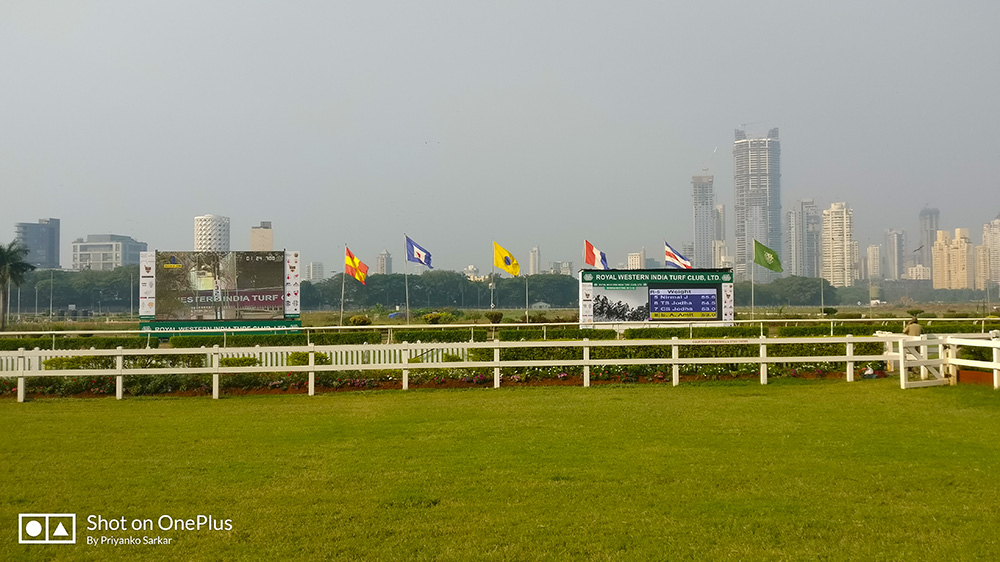
Modelled on Melbourne’s race course, Mumbai’s Mahalaxmi Racecourse is where the rich and famous come dressed in their very best whenever horse riding competitions take place during the November to April season.
Various derby competitions during this time attract punters as well as the best horseracing talent from across the country.
The Grandstand, a designated heritage structure, is a sight to behold and quite familiar to anyone who watches Bollywood movies with any horce-racing element in the plotline.
It is usually allowed to enter here when matches aren’t on. The antiquated lot boxes and old-style washrooms are also worth checking out. For those not interested in the Grandstand, there are chairs near televisions from where you can catch the live action as well.
The 225 acres of green lung in the city’s centre is also open to the general public on non-racing days. As an aspiring marathon runner, I alternate my schedule by running on the racecourse’s mud track once a week from the usual asphalt roads to condition my legs to different surfaces.
I have seen many celebrities and industrialists arrive in their swanky cars and take off in helicopters from the only open helipad in Mumbai at the racecourse quite a few times as well.
Over the weekends, the space outside the track is sometimes turned into an open flea market where pop-up shops and organic producers sell their wares to high-heeled customers. And when it’s all over, some of the city’s best restaurants such as Neel, Keiba, Tote on the Turf and Gallops await you.
2. Sanjay Gandhi National Park
Here’s something from Rashmi & Chalukya from Go Beyond Bounds
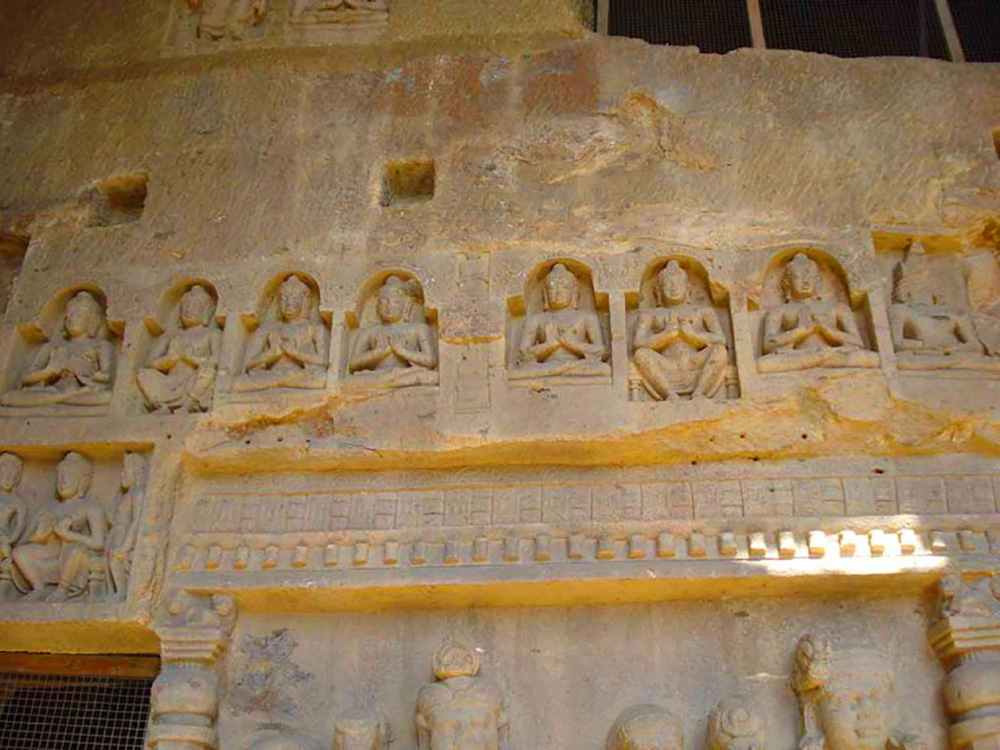
Sanjay Gandhi National Park formerly Borivali National Park is one of the largest national parks in India. The park is a great respite from the bustling city of Mumbai.
There are plenty of things to do in the Sanjay Gandhi National Park. You can go on the lion and tiger safari if you fancy watching the Wildcats in enclosures.
Hike up to one of the oldest Buddhist caves in India the Kanheri Caves and explore the intricate carvings and paintings. Or just stroll around the park and explore more than 1000 plant species and diverse fauna consisting of mammals, reptiles, birds, insects, and butterflies.
The park is located around 10 minutes walk from the Borivali local station and open from 7:30 AM to 6 PM and the caves from 9 AM to 5 PM. Both park and caves are closed on Monday.
3. Mani Bhavan
Nisha and Vasu from Lemonicks will tell you about our beloved Gandhiji!
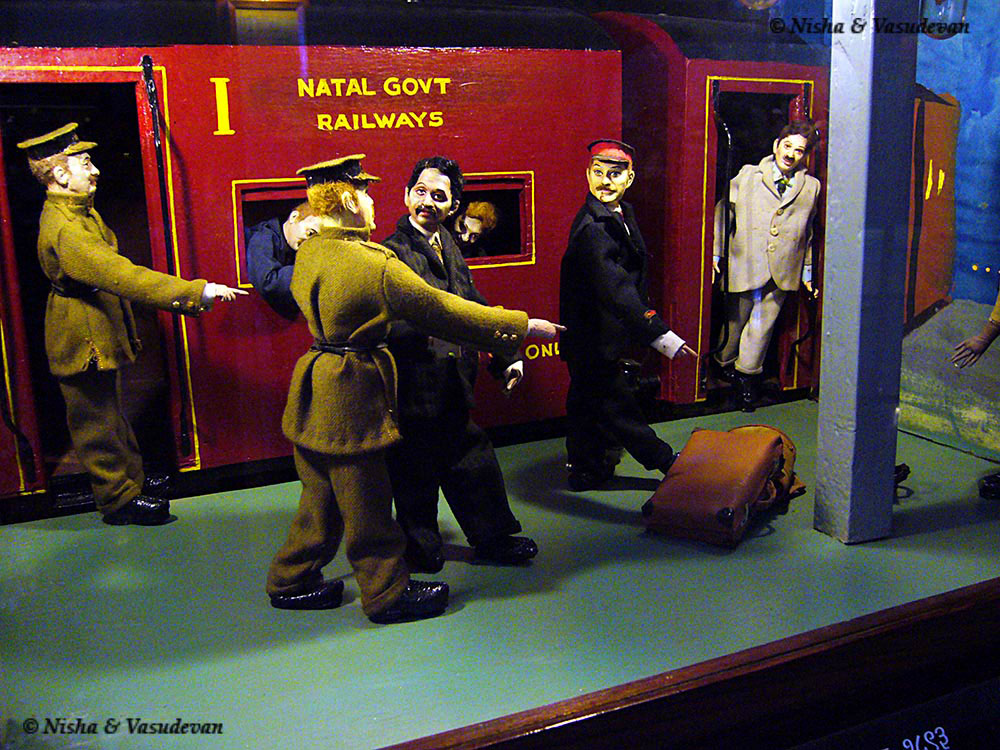
Hidden behind big trees on a quiet street called Laburnum Road in Gamdevi, is Mani Bhavan, one of the secret gems of Mumbai.
Once home to one of the most famous icons of the century Mahatma Gandhi, Mani Bhawan is an old building. It was Gandhi’s residence whenever he stayed in Mumbai.
This heritage structure has now been converted into a museum and research center. The ground floor houses a reference library with over 50000 books and a photo exhibition of the Gandhi’s life. The rest of the museum and the auditorium are on the upper floors.
But what makes this museum interesting is to see the life of Mahatma Gandhi being portrayed thorough hundreds of well-crafted figurines.
Through hand-made doll-sized figures the artist has portrayed the history of the freedom struggle of India. Part of the museum, these figurines are very detailed.
Entry is free and the museum is open on all the seven days.
4. Bandra Bandstand
Here’s a bit from Sinjana from Backpack & Explore
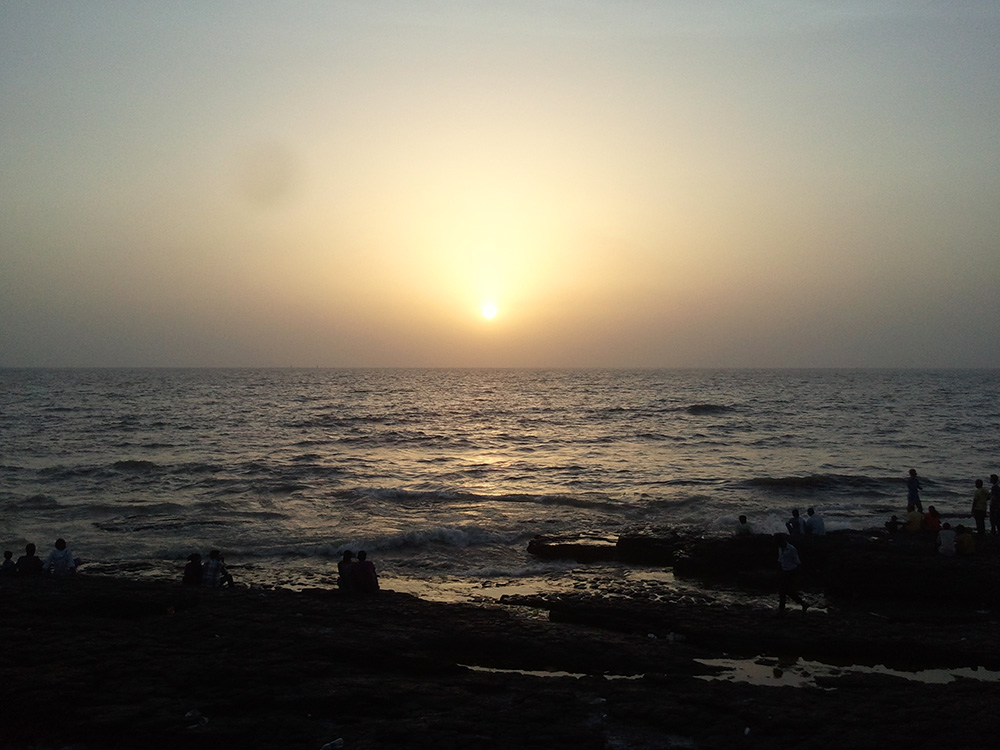
It’s not beach, it’s the Bandstand! Bandra Bandstand is a walkway along the coast of Arabian Sea in Mumbai which is famous for the glorious sunset view and for many Bollywood celebrities who live there.
The jogging track that starts from the Bandra Promenade, goes past the park and ends at the scenic Bandra fort, a Portuguese watchtower built right across the sea in the early 17th century.
Another historic landmark within 1 km radius is the Mount Mary’s Basilica, the oldest church of Mumbai with stunning architecture.
About 2.5 km from Bandra Bandstand lies the famous Bandra-Worli sea link, a cable-stayed bridge connecting West Mumbai to the Nariman point. All these places have been extensively featured in Hindi movies.
5. The Taj Mahal Palace Hotel
By Jill from Reading the Book Travel
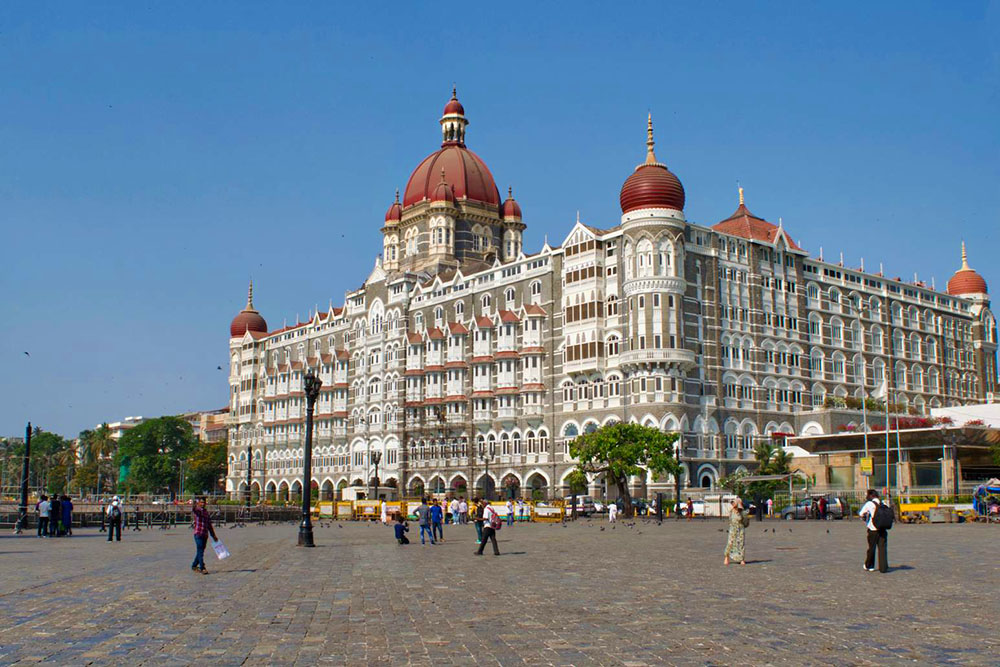
The Taj Mahal Palace Hotel is one of the icons of Mumbai’s Colaba district. First opened in 1903, it occupies an enviable position directly opposite the Gateway of India, and remains arguably the most exclusive hotel in the city.
However, if your budget doesn’t extend to spending the night, no matter. The Taj is open to all those who want to come and admire the marble floor of the lobby or browse the luxury stores housed in its ground floor.
The hotel has several restaurants and bars at affordable prices by western standards, as well as a coffee shop selling the best of India’s cakes and pastries.
Try a cocktail (the Bombay Blazer was my personal favourite) and admire the view over the ocean. And the air-conditioned cool is a welcome break from the city outside!
A note from Abby
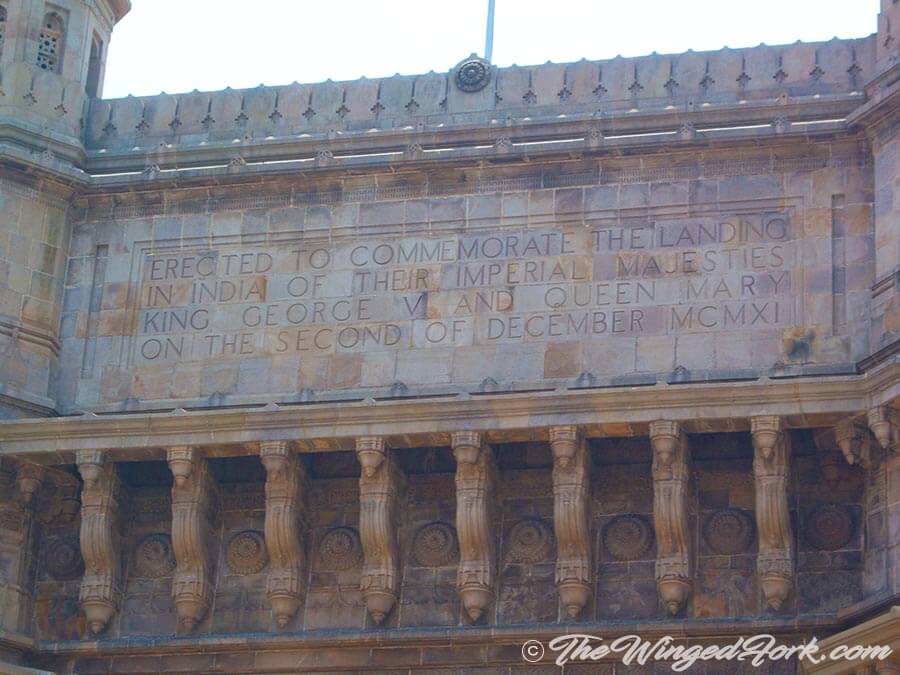
There is a writing inscribed on the Gateway of India reads,
“Erected to commemorate the landing in India of their Imperial Majesties King George V and Queen Mary on the Second of December MCMXI”
6. Dharavi
By Jill from Reading the Book Travel
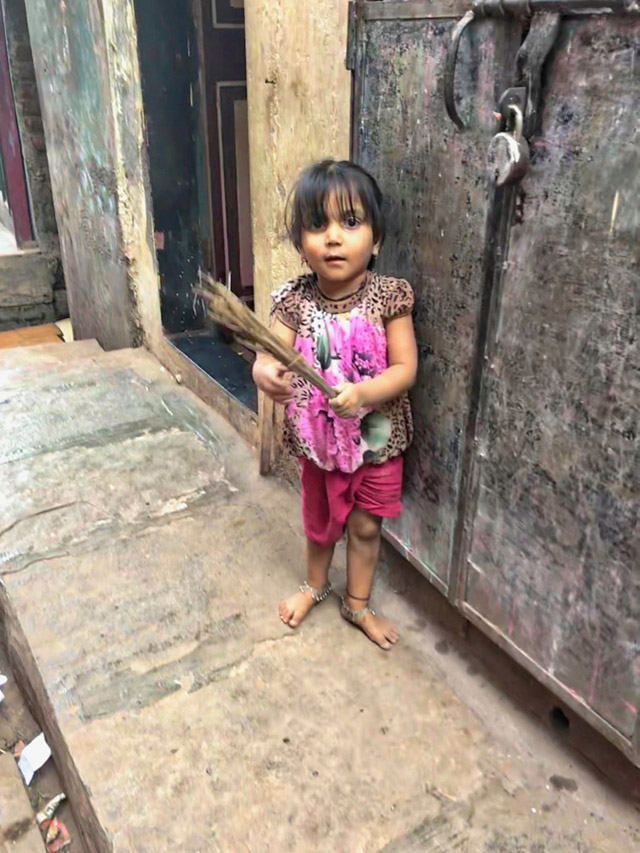
In a city full of fascinating places to visit, Dharavi stands apart.
Made famous by the film Slumdog Millionaire, Dharavi is actually a world away from the images of the film. Poverty is all around you, and yet the district is a testament to the work ethic and will to survive of the people of this part of the city.
Recycling is big business here, with the older residents combing the streets for anything and everything that can be repurposed.
Cardboard boxes are flattened and collected for reuse by cottage industries; plastics of all types are broken down into pellets for reuse in industry. If there’s a way to collect and reuse it, Dharavi residents are doing it.
Pottery is also big business here, with whole families churning out pallets of ceramic jars and other useful household items.
The whole process takes place in the crowded streets of the slums, where children run barefoot past huge kilns which pump choking smoke into the air.
But the sense of community here is strong, and people take pride in their environment. We passed a small girl, no more than three or four years of age, who had collected a bundle of sticks and was sweeping her front step as she had no doubt seen her mother do. Dharavi is undoubtedly poor, but its people are inspirational.
7. Chhatrapati Shivaji Terminus
Andra from Our World to Wander has wandered around the amazing
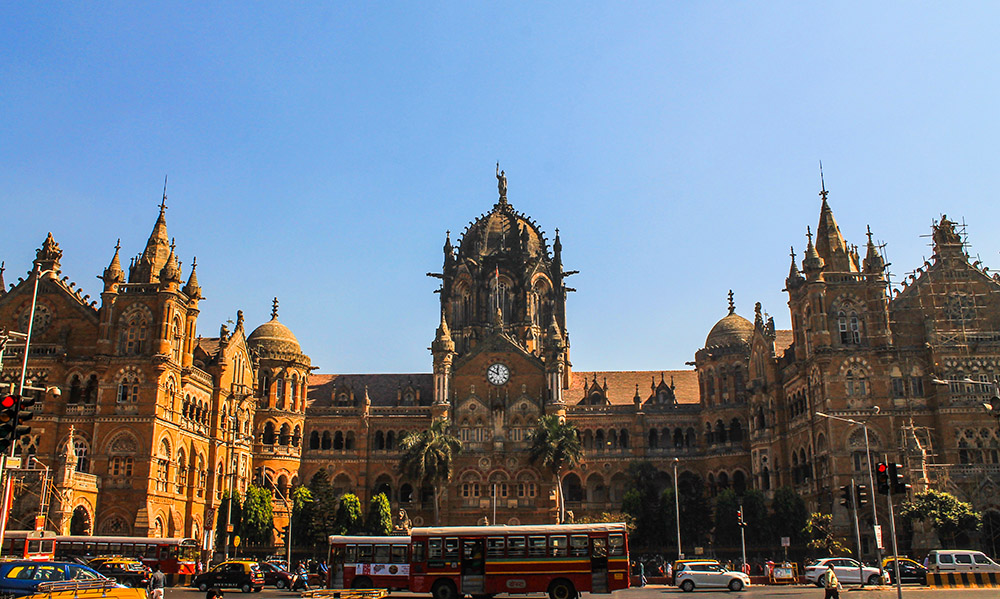
If I were to pick just one building in Mumbai, I would choose the Chhatrapati Shivaji Terminus station without even blinking.
It is so impressive that you could easily stare at it for hours without getting bored. It is probably one of the most beautiful railway station buildings in the world.
It is an example of Victorian architecture, and its splendid features have put it on the UNESCO World Heritage List. It is also an excellent place for people watching as there are thousands of people passing there every day.
8. The Oval Maidan
By Sarah from A Social Nomad
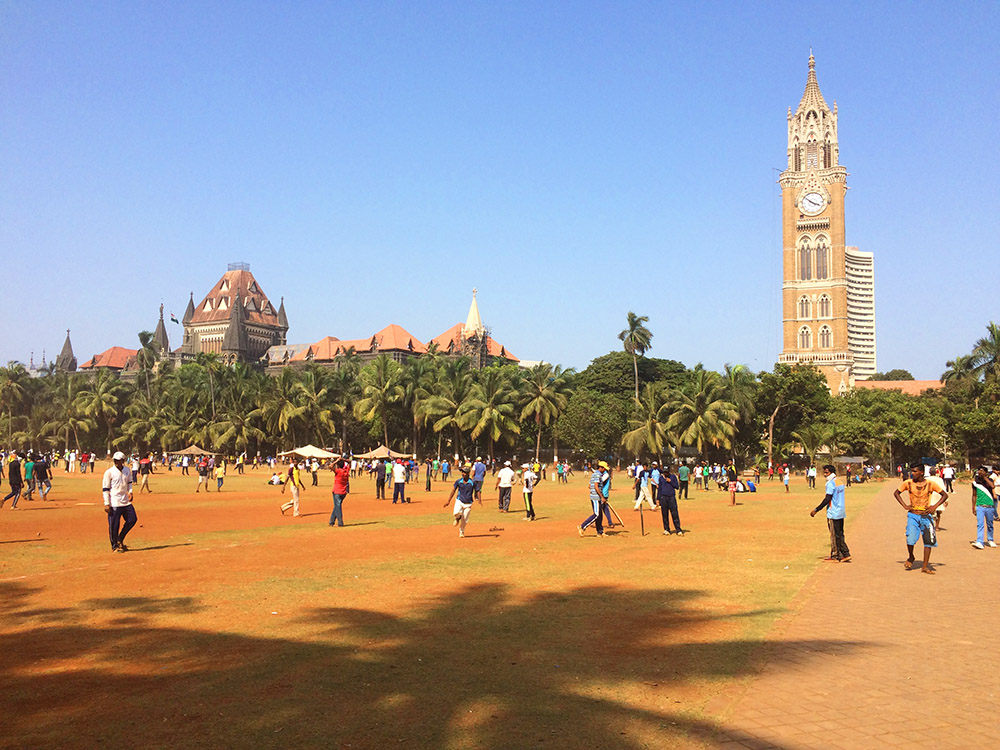
If you want to experience Mumbai as a local, then head to the Oval Maidan on a weekend. This is are creation ground of 22 acres. There are no politics or religious gatherings allowed here, just sports.
You’ll find it in South Mumbai. It’s oval in shape and surrounded by some stunning architecture – with the Mumbai High Court Building along one side of it, the University and the Rajabai Clock Tower too.
You may find football played here, and you’ll certainly find cricket being played. Hundreds and hundreds of games going on simultaneously. The games are of varying standards, but all taken extremely seriously. Each batsman aiming to be the new Virat Kholi and each bowler the next Ravichandran Ashwin.
You’ll be hard pushed, even as a cricket fan, to work out who’s part of which match there are that many going on during the season. I loved the sheer energy of the place, the fun, the seriousness of the games going on and the thought that one of these guys might be a superstar of the future.
9. Gateway of India
Ketki from Dotted Globe will tell you more!
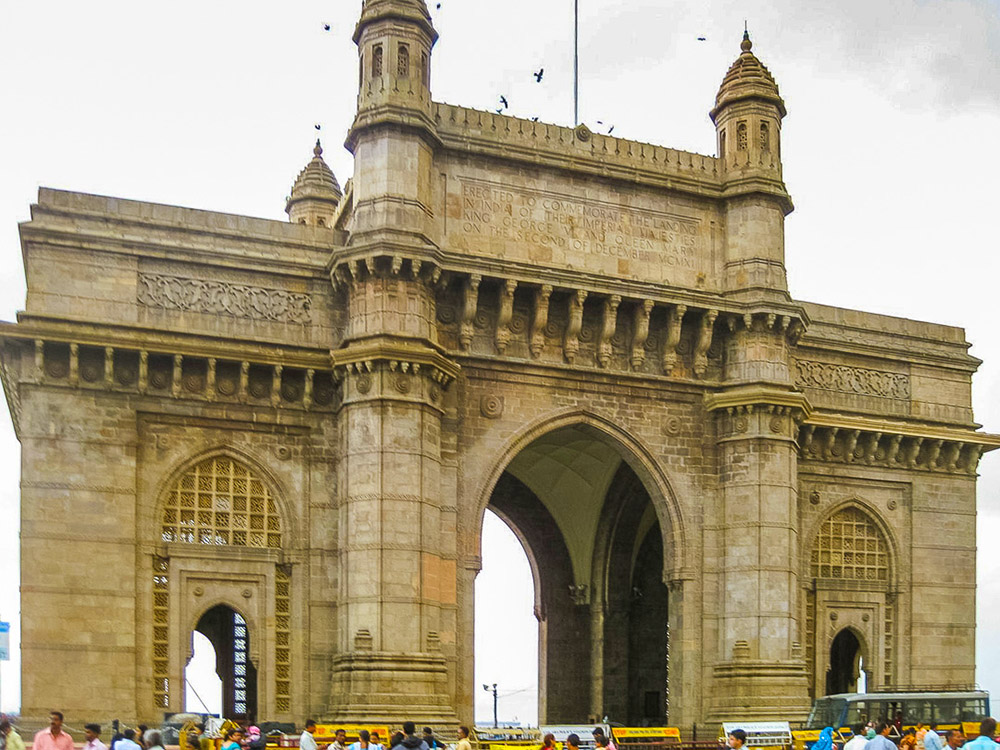
An incredible architectural work from British Colonial times, the Gateway of India is one of the must-see places in the country.
It was built in 1920 to commemorate the visit of King George V and Queen Mary to colonial Bombay. Designed by architect George Wittet, the Gateway has a great blend of British colonial style and the Indian style. For years, the Gateway served as symbolic entry and access to India for visiting royalty, viceroys, governors, and important guests.
The Gateway with its turrets and intricate detailing is a top tourist attraction in the city. A unique feature about the Gateway is that it also played an important part in the Indian Independence celebrations.
The last battalion of British troops marched out of Mumbai through the gate and the last British ship set sail for England at the Gateway.
10. Crawford Market
Rashmi and Chalukya from GO Beyond Bounds
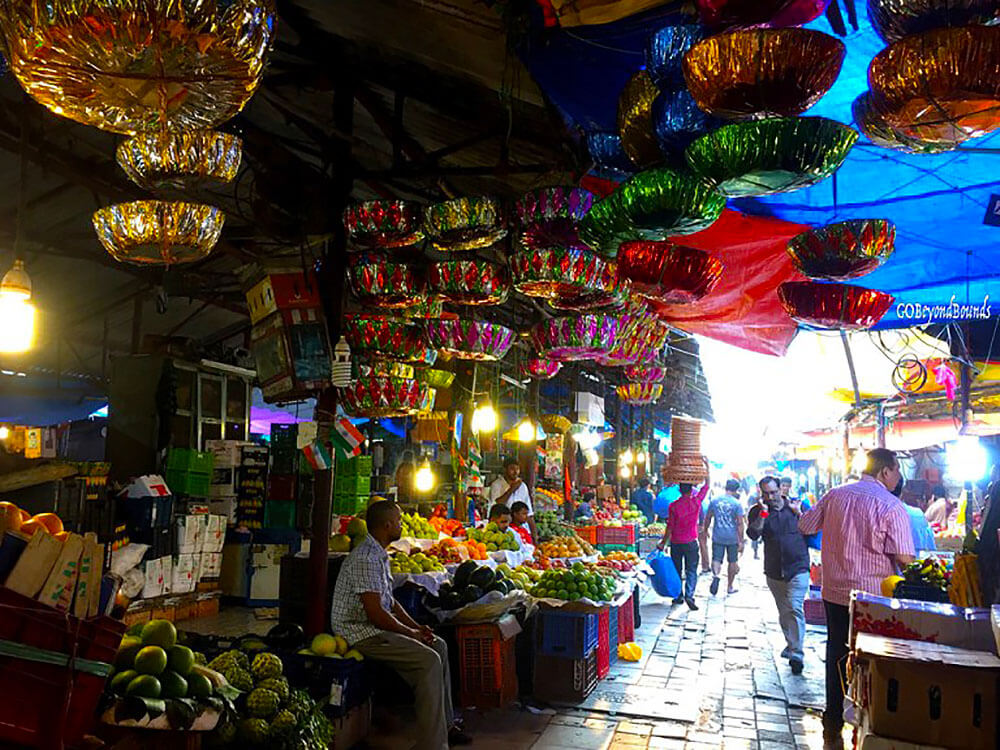
The bustling city of Mumbai is shopper’s paradise. You will find plenty of options here from shopping streets to lavish malls. Crawford Market locally known as Mahatma Jyotiba Phule Mandai is one of the popular and oldest wholesale markets of Mumbai.
The market is housed in a 19th-century historic building. There several stalls inside the closed markets which sell dry fruits, spices, fruits and other wholesale items. The market also once sold exotic pet animals which were imported.
Make sure to visit the market in the morning as by noon the markets sell off all the wholesale goods. The market is closed on Sundays.
The nearest station to the market is Chhatrapati Shivaji Terminus railway station. Close to the Crawford Market are the famous Zaveri Bazaar and another famous wholesale market Mangaldas Market.
11. Marine Drive
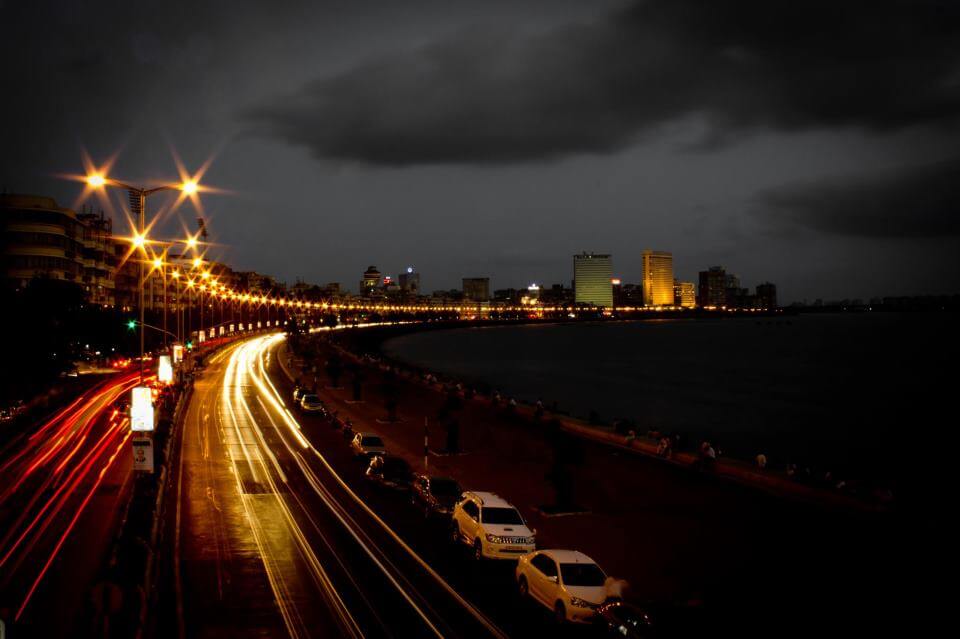
A 3.6 km long stretch along a natural bay that looks like a string of pearls and is lined with palm trees that looks like the Promenade d’Anglais in Nice. What else can adorn Mumbai?
The Marine Drive built by Pallonji Mistry and Bhagojisheth Keer is also known as the Queen’s Necklace. My favorite pic though, is the one above, by my friend Vikram who guest posts for me sometimes. It’s simply perfect!
If you’re wondering about how to get this sort of pic. No, you don’t need a drone.
You drive onto the Marine Lines flyover from Princess Street (now called Shamaldas Gandhi Marg). Seriously, why change a perfectly good name. Have you heard anyone giving directions locally? ‘Take Princess Street and go to…’, ‘Go right from Princess Street’, etc. It will always be Princess Street to everyone who lives here.
And while you’re on Princess Street, before you catch your cab, taste some of the amazing desserts from Paris Dairy Farm.
Now where was I? Right, the pic of the Marine Drive. There is a particular spot on the Marine Lines Flyover just before it turns right onto the Chowpatty Seaface where you can stop your car for a few seconds and take pictures of the Queen’s Necklace.
From this point on the flyover, you’ll get almost picture perfect shots of both the North and South sides of the Marine Drive.
There’s also an old stair bridge that goes up to this spot that’s technically closed. But it’s still frequented by college kids who want to hang out and just chill with great views of Marine Drive and the sea.
12. Blue Synagogue or Keneseth Eliyahoo Synagogue
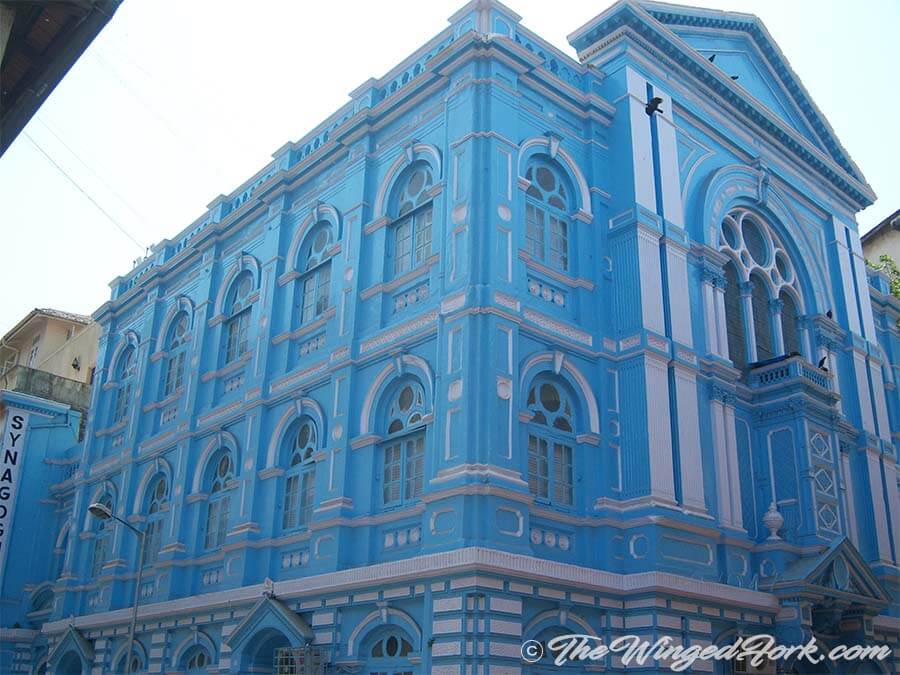
David Sassoon hired the architects Gostling & Morris to build the Knesset Eliyahoo Synagogue in 1884 to give the Jews of Bombay somewhere to worship.
My sister’s friend Judah Samuel who worked at the Ministry of Tourism for Israel used to invite us to Pesach services and other events. (May his memory be a blessing!)
The synagogue was designed with a stone masonry base and a superstructure of brick masonry. The outside of the synagogue is painted blue and white.
Knesset Eliyahoo Synagogue is located at 55, Dr. V.B. Gandhi Marg, Fort, Mumbai.
13. Magen David Synagogue
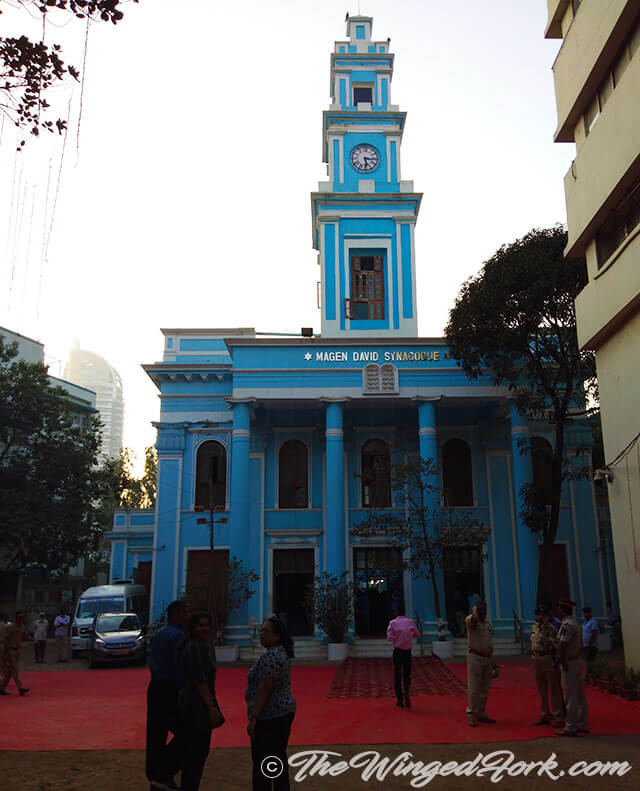
More of the Baghdadi Jews fled from the persecution in Baghdad to Bombay in the 1800’s. To give the growing Jewish population in Mumbai a place to worship David Sassoon had the Magen David Synagogue built in 1864. This synagogue is probably one of the largest in Asia outside of Israel.
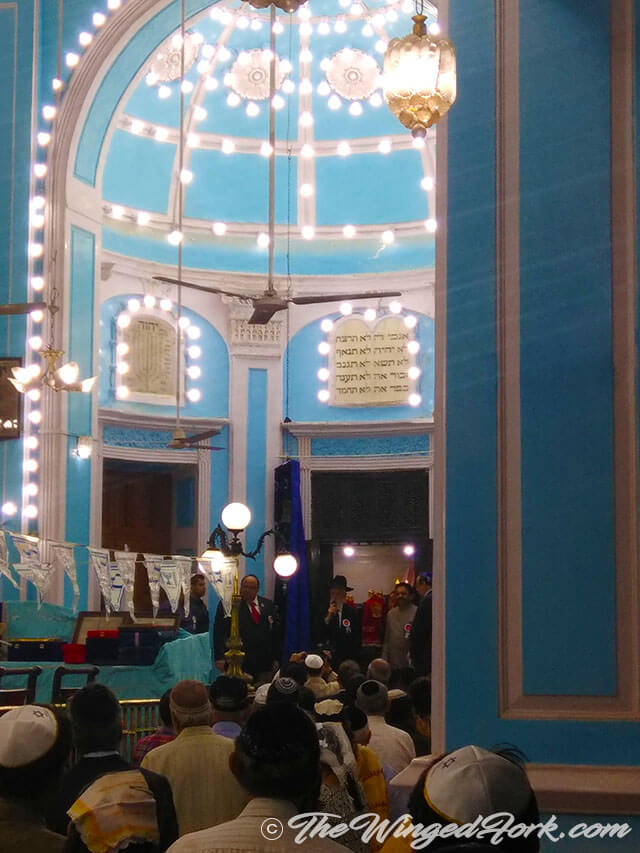
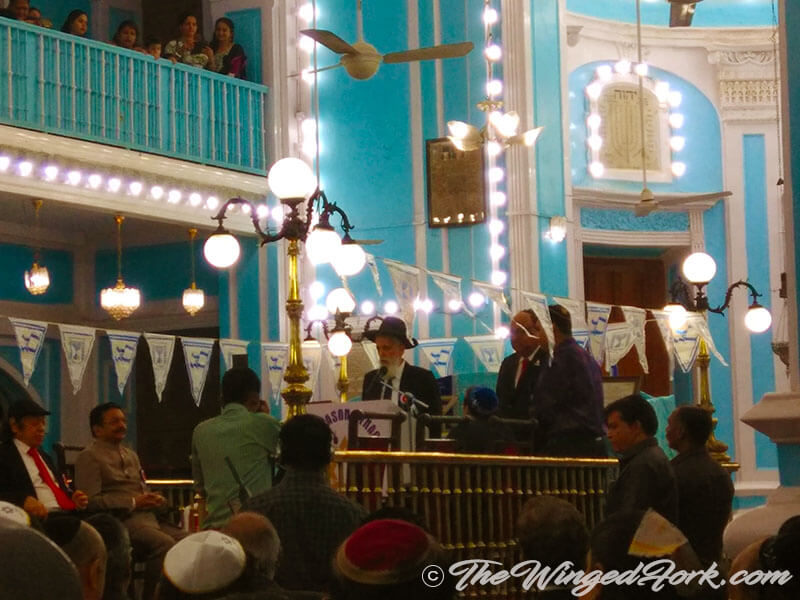
We visited again recently to attend the celebration for the 175th anniversary of the Shaare Rason Synagogue here. The event was graced by the Governor of Maharashtra, India, H. E. Ch. Vidyasagar Rao, along with guests of honour Rabbi Romiel Daniel, the President of the Indian Jewish Congregation of USA and Rabbi Ya’aqob Menashe, the Senior Leader and Trustee of the Sir Jacob Sassoon Charity and Allied Trusts and Synagogues, India.
The Consul General of Israel for India was also present, along with Judah David Samuel, the President of the Syangogue and Sinora Kolatkar who campaigned for the restoration.
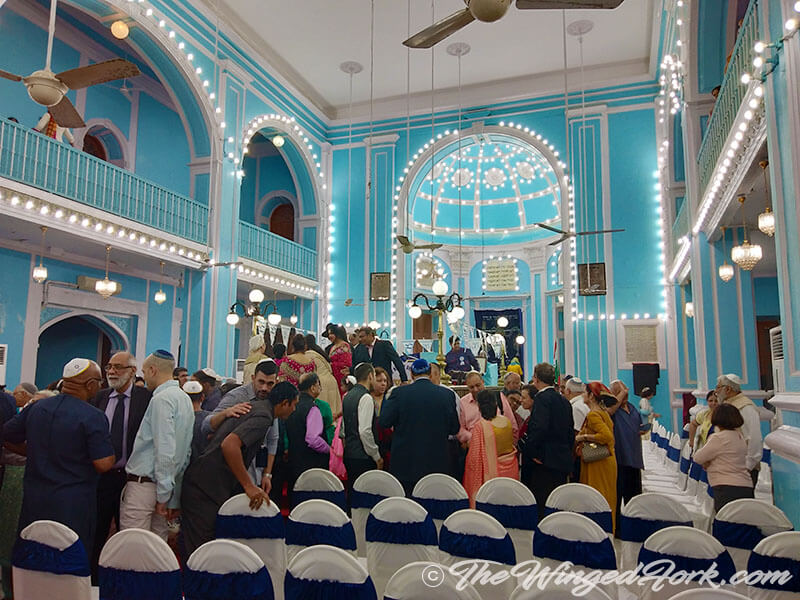
The Magen David Synagogue is located at 340, Sir J. J. Road, Opp Richardson and Cruddas Ltd, Byculla, Mumbai.
14. Marve Beach
By Sarah, writer at The Winged Fork
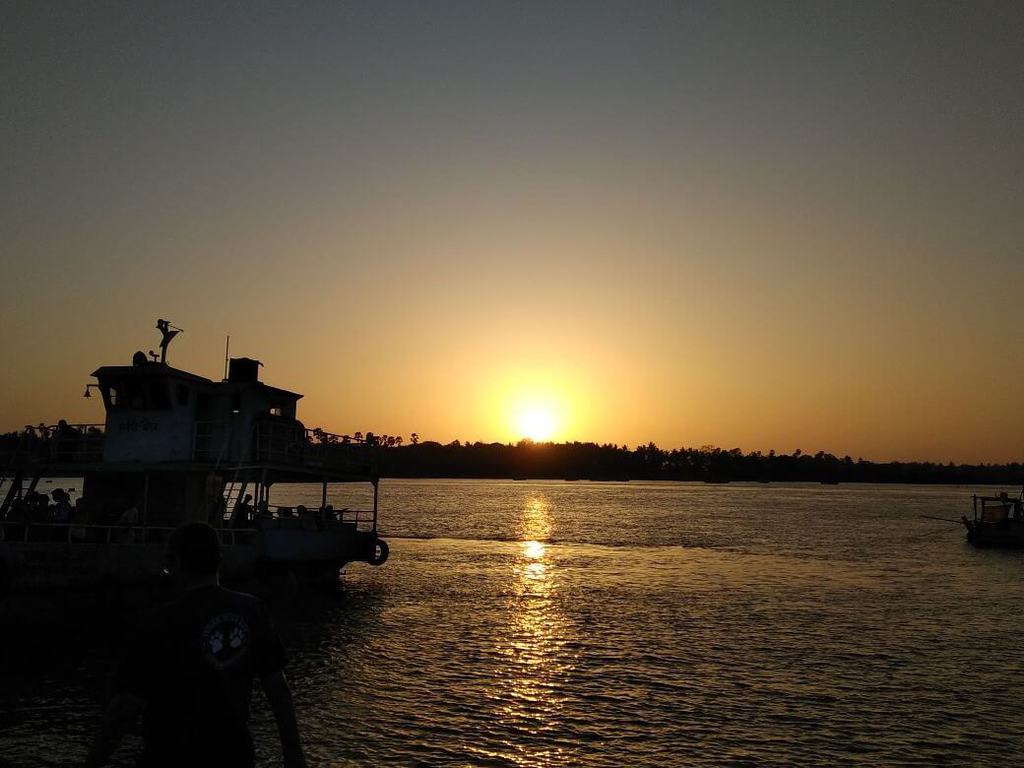
With picture-perfect sunsets such as the pic above by my sis Sarah, one would think that Marve beach is ideal for picnics.
But behind the beauty lie the dangers of a perilous sea. The children frolicking around near the shore betray swift currents that are not safe for swimming along with sinking sand. The beach is also restricted because of the Indian Naval Base present there.
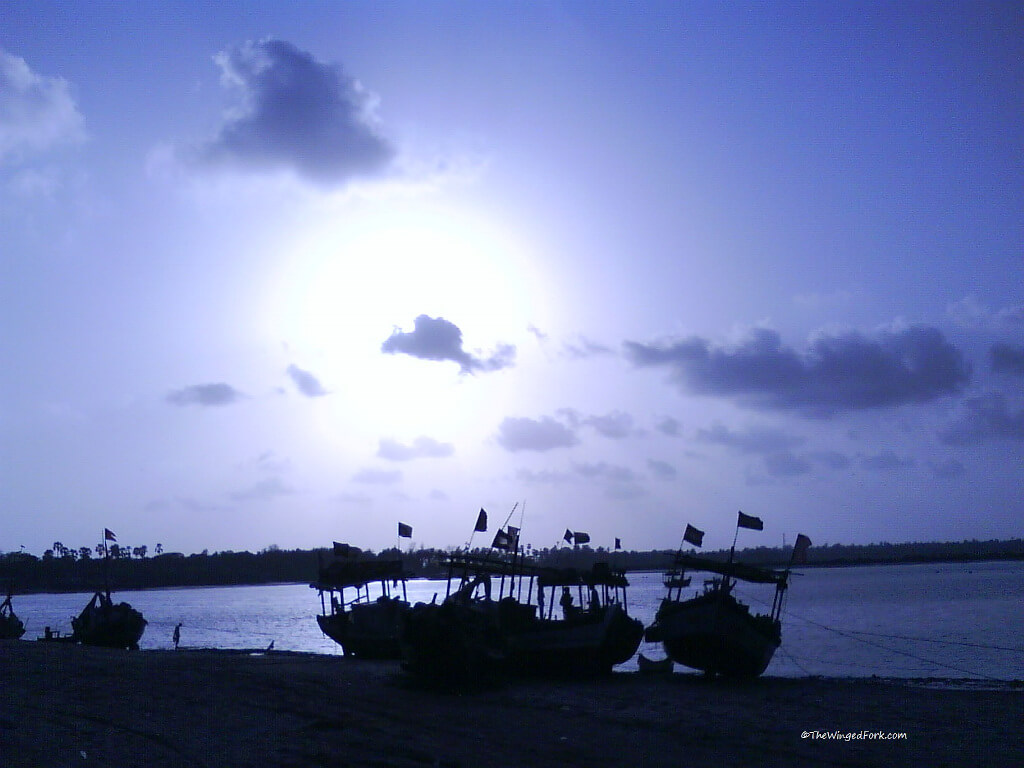
In the evenings, you can buy fresh fish from the local fisher ladies, or enjoy a bhel or pani puri.
Or take the ferry across the creek to Manori Island where you can be reminded of days long past or take a tonga ride amidst the old houses and tree-lined streets to get to the Kaka Baptista East Indian Museum.
Or spend the night at the remaining farms or shacks where you can taste a bit of local culture and enjoy the warm breezes.
But if you want to see where Mumbai gets the fish that’s on your plate, take a tour of Sassoon Docks after visiting the churches!
15. Madh Beach
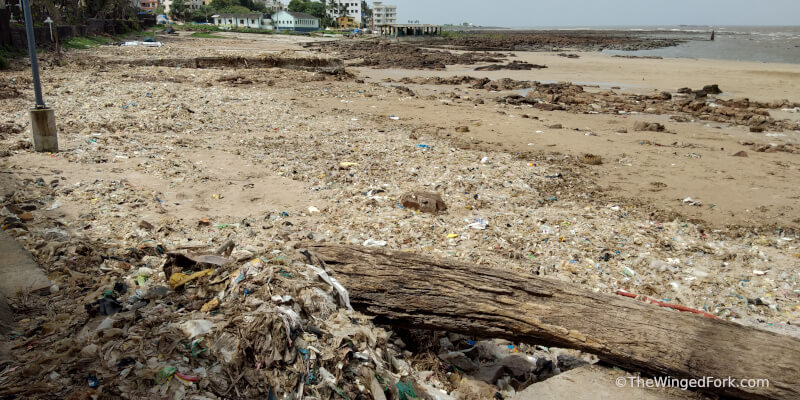
And then there’s Madh Beach with the smell of salt in the air, and the fishing boats going out to sea. There’s also the fish and prawns set out to dry on tarp near the shore.
When we were kids we used to go here and go swimming often. Nowadays, we stick to the pool at the holiday home in Madh.
Why?
Just look at the pic. There’s trash everywhere. This pic is of the rocky South side of the beach with the Madh ice factory and fish market in sight. The plateaued North side is not that great either.
At least, there was still loads of it when we went a few months ago in August. Why do people think the seas in our country are dustbins? Will we ever change?
16. Church of St. John the Evangelist or Afghan Church
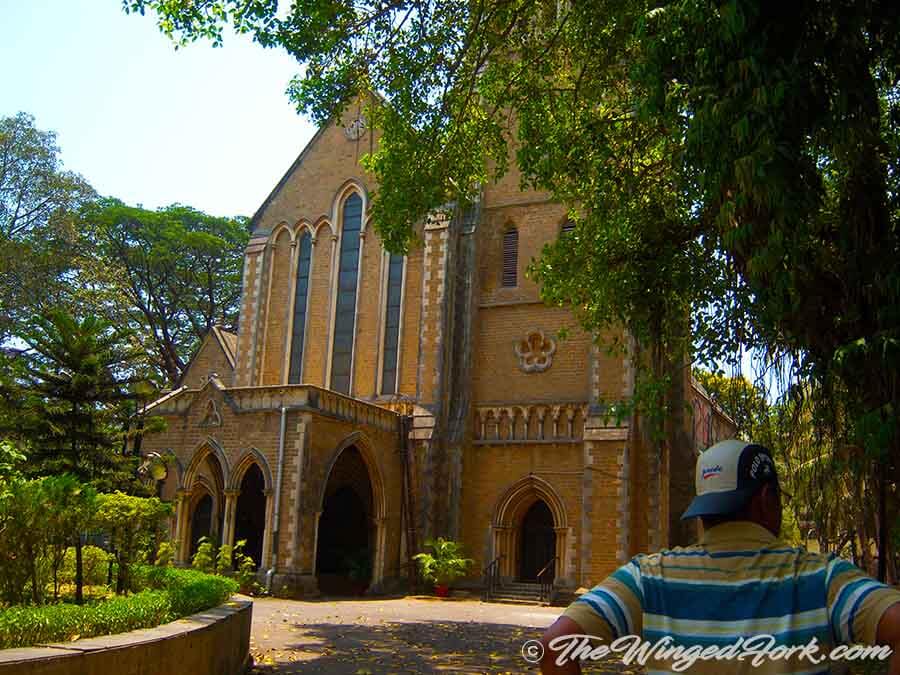
There’s an inscription on the marble cancel that reads:
“This church was built in memory of the officers whose names are written on the walls of the chancel and of the non-commissioned officers and private soldiers, too many to be so recorded who fell, mindful of their duty, by sickness or by sword in the campaigns of Sind and Afghanistan, A.D. 1838-1843.”
Just one sentence.
And it conveys the terrible loss of lives in the First Afghan war.
The Church of St. John the Evangelist, locally known as the Afghan Church, was built to commemorate the British soldiers who lost their lives in the retreat from Kabul, Afghanistan in 1842.
Every time we visit this church, it seems to be telling us the story in a different form. An inscription we didn’t notice before; a plaque that calls out to us; the worn ribbons on the wreaths. They all tell stories of lives lost before their time.
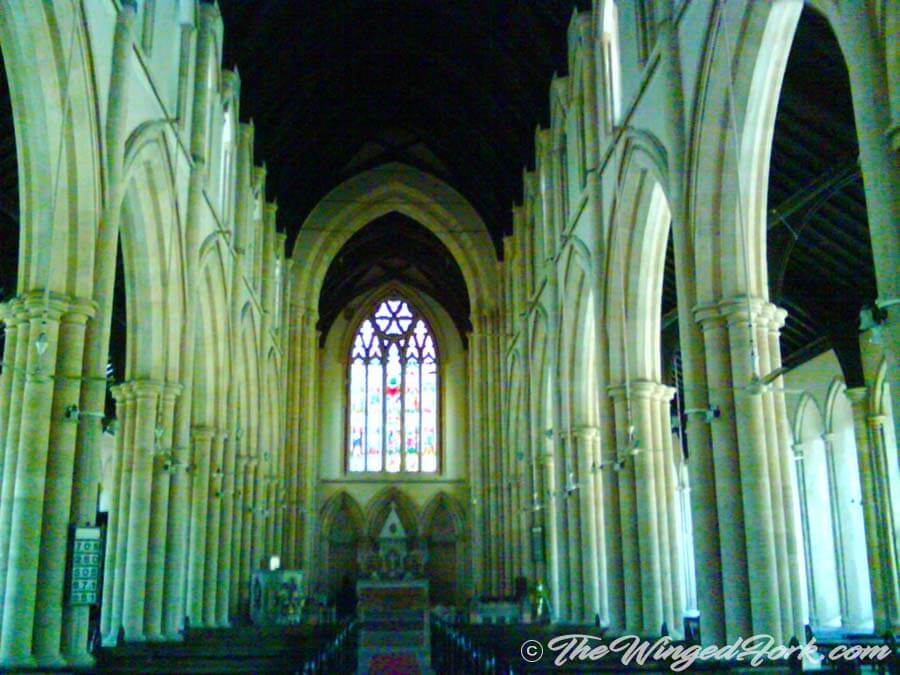
Set in Navy Nagar, Colaba surrounded by a few tall trees, this Anglican Church also holds memorials to the dead lost in the Second Afghan War.
In the early 1840’s, the faithful were attending church in a makeshift chapel in what was then called the ‘Sick Bungalows’ and is now the naval hospital INHS Asvini.
The East India Company’s Bombay Chaplain, Rev. Piggot wanted construction of a permanent church, and after some efforts the foundation stone was laid on 4 December 1847, and the Bishop of Bombay, John Harding consecrated the Afghan Church on 7 January 1858. The spire, however, took longer and was completed on 10 June 1865.
Henry Conybeare, designed the plans for the magnificent church structure with its 60 metre high tower and spire can even now be seen from afar off against the backdrops of the buildings.
Students from the Sir Jamsetjee Jeejeebhoy School of Art designed the reredos under guidance of the architect William Butterfield. He also designed the Afghan War Memorial mosaics, screen, choir stalls, pews and the polychrome floor tiles.
The beautiful stained glass windows were designed by the stained glass expert William Wailes. And the bells were made in the Taylor Foundry in England in 1904.
The gothic arches and beautiful stained glass windows make you think you’re in a chapel in Europe somewhere.
17. Aksa Beach
A popular beach, Aksa is a picnic spot and a snack spot where locals spend their evenings. Although the beach is not safe for swimming, shacks and hotels such as The Retreat and others are frequented by Mumbaiites and tourists. Eat bhutta aka roasted corn or bhel puri from the pebblers on the beach. 😉
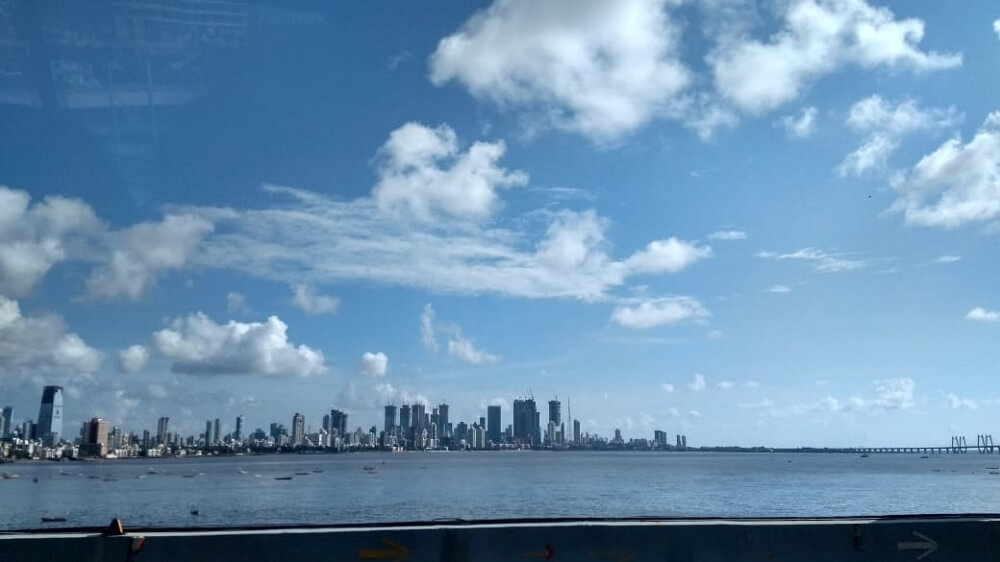
Bandra Worli Sealink – Pic by Sam Khedekar
18. Bandra Worli Sea Link
Okay, maybe it’s not as big as the Viaduct de Millau, the tallest bridge in the world. But the Bandra Worli Sea Link, a cable stayed bridge over the Mahim Bay in Mumbai, India has been a godsend for the people of India, Bombay City.
It reduces an otherwise long 30 minute commute to a 10-minute one, and has an average traffic of 37,000 vehicles a day. Of course, it also has the normal everyday problems like traffic, a few ptholes and more. But what’s a road without speedbumps in Bombay?
19. Gorai Beach
A tiny part of the Salsette Island, Gorai was once a beautiful beach for locals to go to for family picnics. All you had to do was cross the Gorai creek by boat, take a tonga ride or a bullock cart ride and reach these lovely old houses where you could spend a lazy afternoon or stay overnight.
Nowadays, although you can still do that, you won’t like to go swimming in the water anymore. Too much pollution! But it’s still a great place to enjoy the slow life and see what’s left of times past.
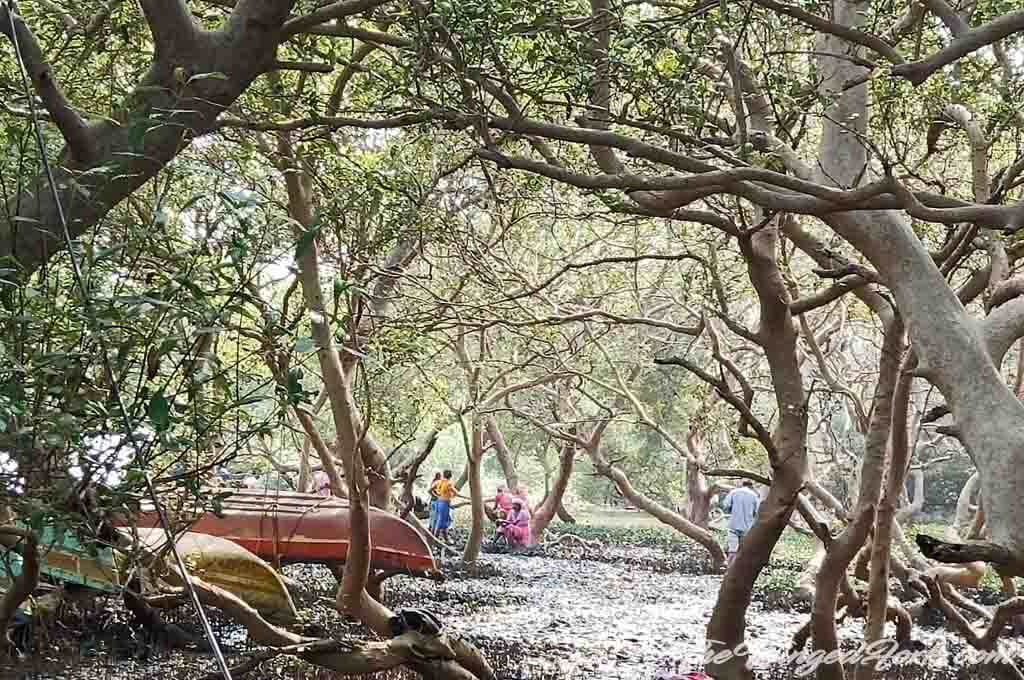
This pic above, it’s those people who look through the muck to collect newties. Just watching them dance around in the muck, or should I say marshy land, while these guys try to catch them is fun. Right, I should have mentioned, newties are called mudskippers in English; but you already knew that, didn’t you?
Off the beaten path on the outskirts of Mumbai
1. Elephanta Caves
Here’s a bit by Reshma from Love Travel Things
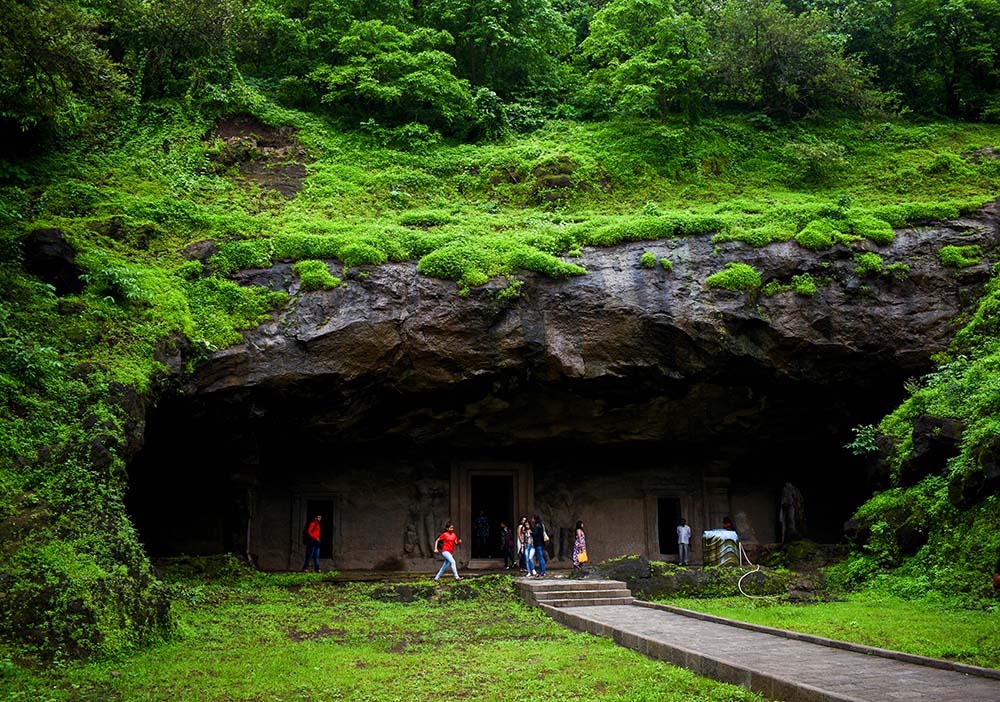
Can’t think of Caves in Mumbai?? Even I couldn’t until I witnessed this beautiful piece of World heritage site. It is about 10 KMs away from Mumbai’s mainland shore in the Gharapuri island better known as Elephanta island and the only way to reach here is by ferry boats available near the Gateway of India.
Get ready to experience the waves splashing onto your faces enroute the journey which takes approximately 1 hour. Also you can spot big cargo ships at the Bombay Harbour. You will get to see the Mumbai from a distance along with the iconic Gateway of India and Taj Mahal hotel.
After getting down from the ferry boats, you can opt to walk a distance of 1 km or take the toy train to reach the downside of Elephanta caves. And from there you have to walk uphill.
There are nearly 110-120 steep steps, which are lined by stalls on both sides. There are many beautiful things you can buy here, like handicrafts, t-shirts, bangles and many restaurants are there.
Best time to visit this place will be during monsoons or in the winter season. Walking during the sunny times might be very tiring.
This place got its name as Elephanta, because a large statue of an elephant which guarded the island before the British attempted to relocate it.
Though it is broken, reassembled pieces now rests at Jijamata Udyaan in Mumbai. There are a total of 7 caves dated back to the 5-7th century AD, carved out of Basaltic rocks, 5 on the western hill and 2 on the eastern hill.
Little I knew about the 2 caves on eastern hill side and the about the trekking trail here which I read after coming back. There should always be a reason to go back, isn’t it?? After all Mumbai has stolen a part of me..
So on the western hill rests a group of 5 temples which are predominantly dedicated to Lord Shiva, overlooking the Arabian Sea.
Out of the Five, 1st cave takes up all the attention, with A three faced Shiva which represents three aspects of Shiva the Creator, the Preserver, and the Destroyer, identified, respectively, with Aghora or Bhairava (left half), Taptapurusha or Mahadeva (central full face), and Vamadeva or Uma (right half) and obviously it is the crowded one.
Also witness the beautiful pillars and other rock cut stone sculptures, most of them destroyed by the portugal during the colonial past. Remaining caves are not as big as the first one, and one can silently sit and enjoy the nature.
If you are interested in history this is a must visit place which rests in the lap of Arabian Sea.
Beware of the monkeys which are hungry and thirsty. Even the bottles they will snatch from you…
2. Sion Hillock Fort
Khushboo from Munni of all Trades
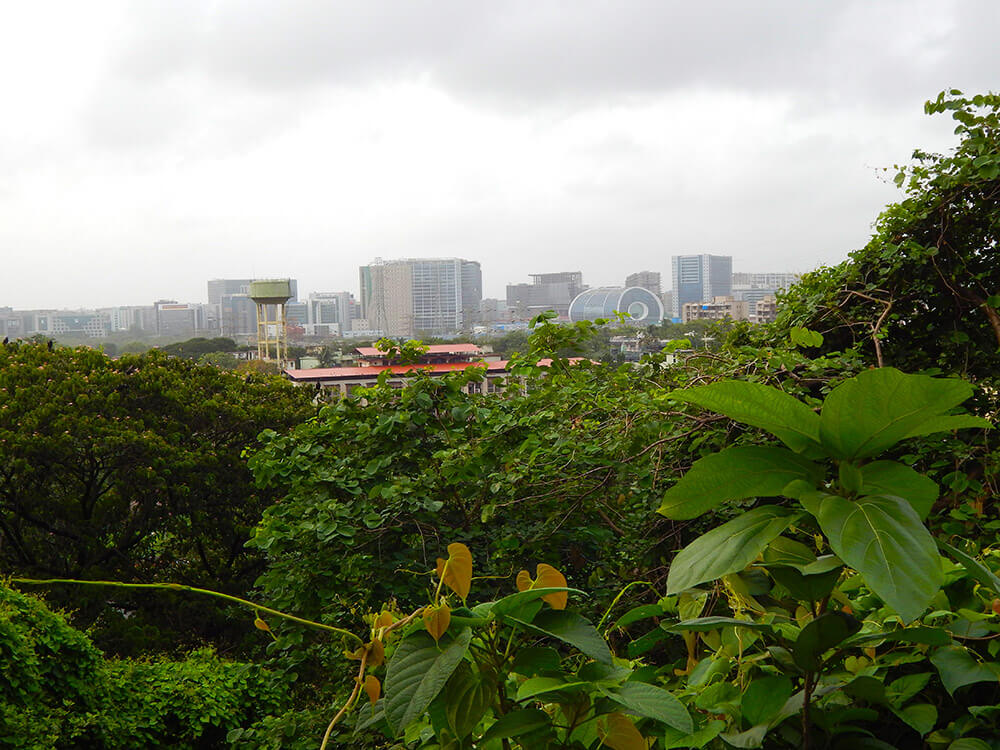
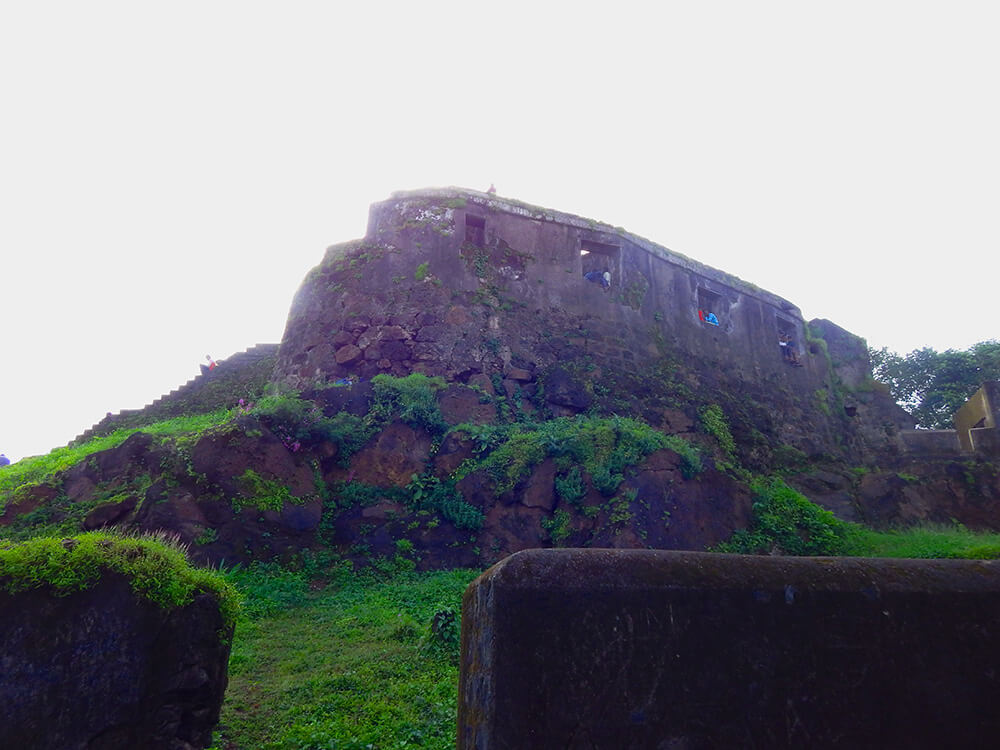
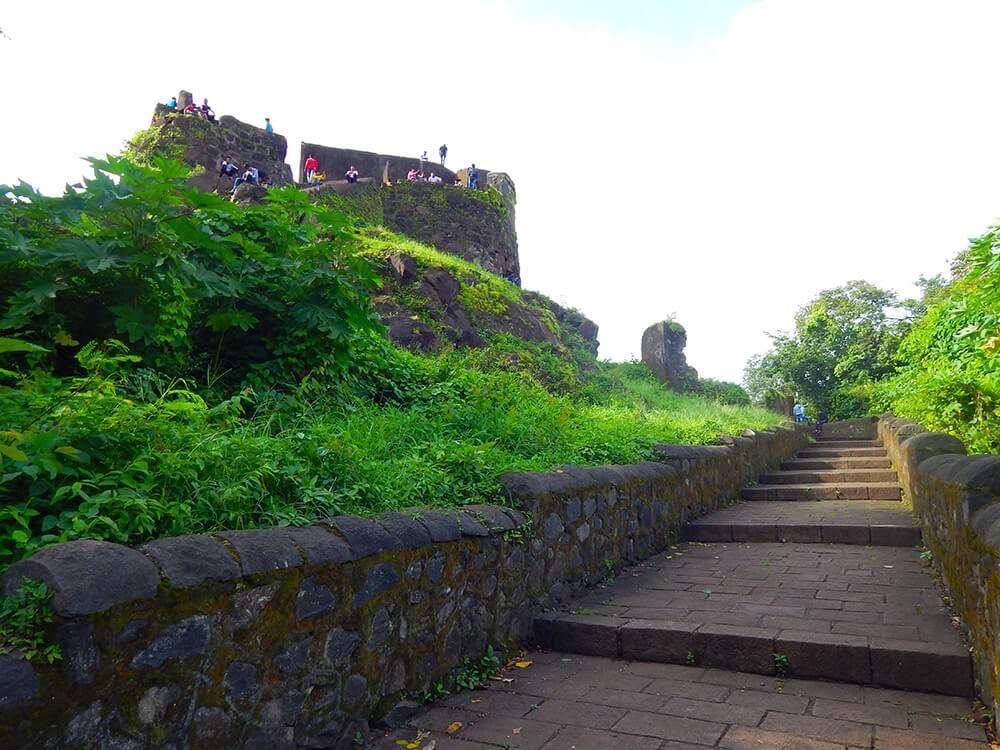
The Sion Hillock Fort has a special significance for me. Located at 10 minutes walking distance from Sion station, this 341-year-old fort built by the East India Company is a place where I spend most of my Sundays.
History reveals that this fort marked the boundary between Salsette Island ruled by the Portuguese and Parel island held by the British.
The fort is in ruins and the stone steps leading you to the top are broken, but the climb is fairly easy for anyone who is modestly fit.
As you enter the fort, you will be greeted by several small gardens created for kids to play. There is an old dysfunctional waterfall made of tiles which now doubles up as a slide for children and adults alike.
The fort is green and lush after the monsoons and attracts a number of parrots. The panoramic view of the city from the top of the fort inspires many budding photographers including myself to spend time attempting to get the perfect shot.
The sunset from the top looks beautiful and is a perfect backdrop for a small picnic with your family.
3. Dhobighat
By Sarah
Lights together, dark together; cottons, wool, denim, sort them all. Try doing that for hundred of clothes a day. Or rather, for 1 lakh. That’s 1 followed by five zeroes. 1,00,000! A hundred thousand clothes washed a day in Mumbai, India.
No wonder Dhobighat featured in the Guiness Book of World Records in 2011 for the ‘most people hand-washing clothes at a single location’.
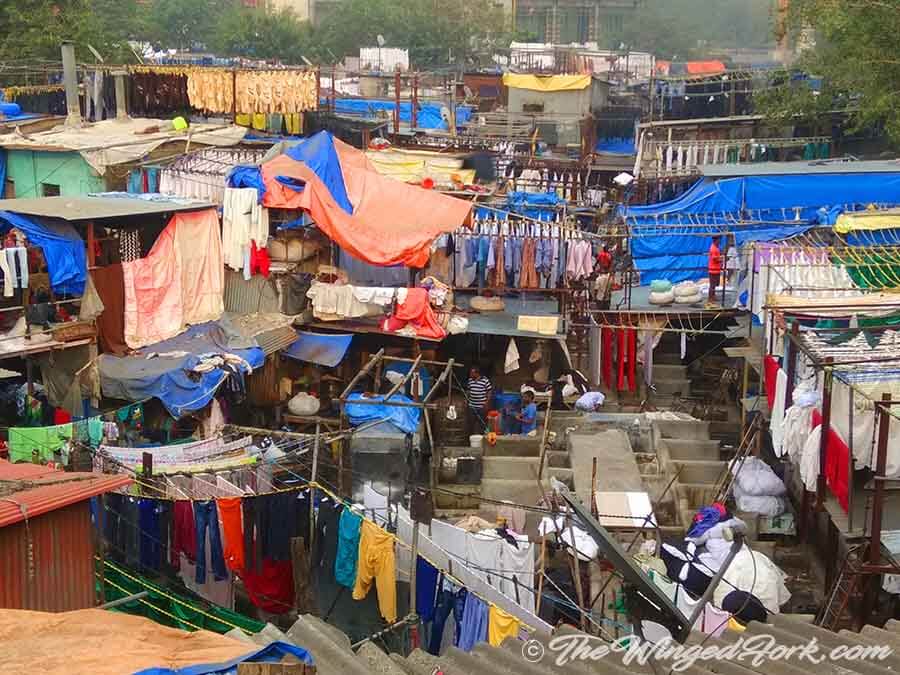
The world’s largest open air laundry, Dhobighat in Mumbai, was built in 1890 and still works in the old style. Over 200 families of around 7000 dhobis live here and most of them have inherited this profession from their fathers.
Clothes from homes, hotels and hospitals all over Bombay make their way to this traditional old laundry. Clothes are sorted based on colors, material and more.
Together they wash clothes by rinsing and hitting them on flogging stones in their open concrete pens. Lines of washed clothes are then hung out to dry. You can see them sorted by colors here.
Some of the clothes then go back to their owners, while some are ironed. It depends on the clients requirements. It’s amazing to see how the dhobis who have little education, have such an efficient sorting and management system.
Enter Dhobighat, and you’ll find a number dhobis offering to guide you for around INR 200. That’s circa 3 to 3.5 USD. It’s interesting to hear the anecdotes from the local dhobis. If you prefer a tour guide, Google has a lot of info on agencies for that.
If you don’t have the time to visit Dhobighat, you can still view them from afar. The best place to get a bird’s eye view of the dhobi world is from the bus stop outside Mahalakshmi (Train) Station.
Just go up the walkway from KK Road to the Mahalakshmi Station bus stop. From there you can see everything – the washing, drying, and more. You won’t get to see the ironing though. For that you need to go down into Dhobighat.
Dhobighat is not necessarily something you have to visit, but if you consider that a few handful of dhobis are working in such an efficient system that they have a turnover of INR 100 Crore (13 Million USD) a year, it’s definitely worth taking a peek!
4. Sewri Mangrove Park and Sewri Fort
A short 20 minute walk from Sion Station is the Sewri Mangrove Park. Of course, we didn’t walk there. The sun was too hot even that early in the morning. So we took a cab. The last bit of the road to Sewri Jetty is now closed to vehicles, and you have to walk about 400 metres to the jetty.
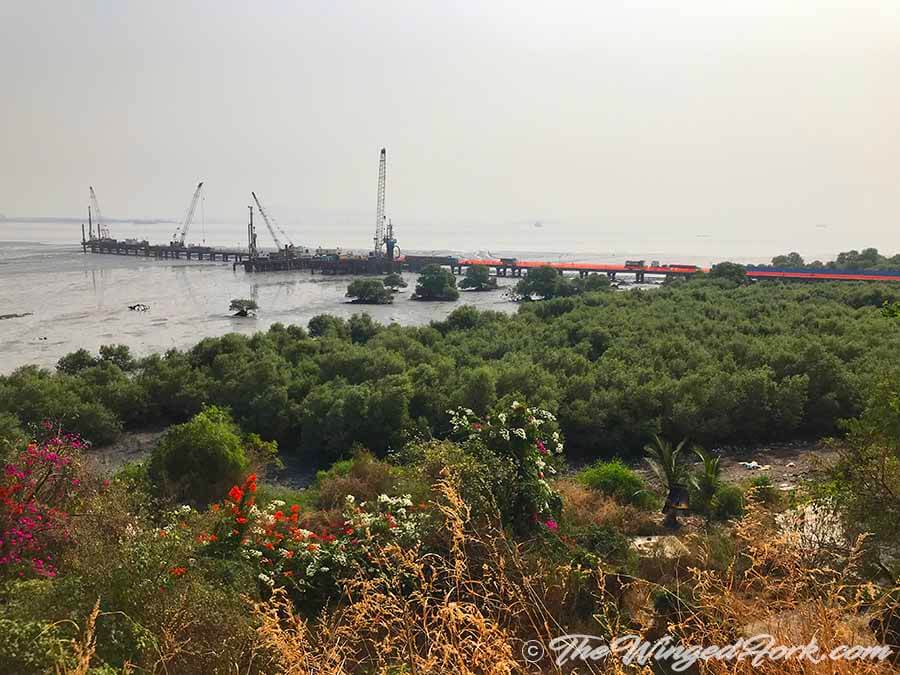
It’s not what it used to be. There’s a Trans Harbor Sealink being built nearby and the noise is scaring away the birds. (The link is expected to be completed by 22nd September 2022.)
So you can only see a few birds nearby, and you can see the flamingos, but they’re afar off during the day. All we could see were tiny pink dots in the mangroves.
And considering we didn’t have my sis and her camera with us, we were doomed. The only thing you can see clearly is the numerous newties aka mudskippers moving about in the muck of the mangroves.
If you come early in the morning though, in the few hours around sunset, when the noise from the construction cannot be heard, you’ll see them closer by.
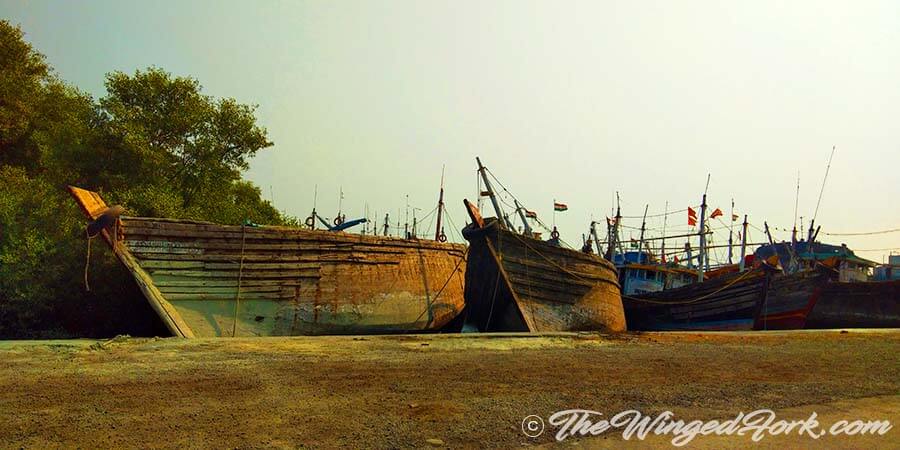
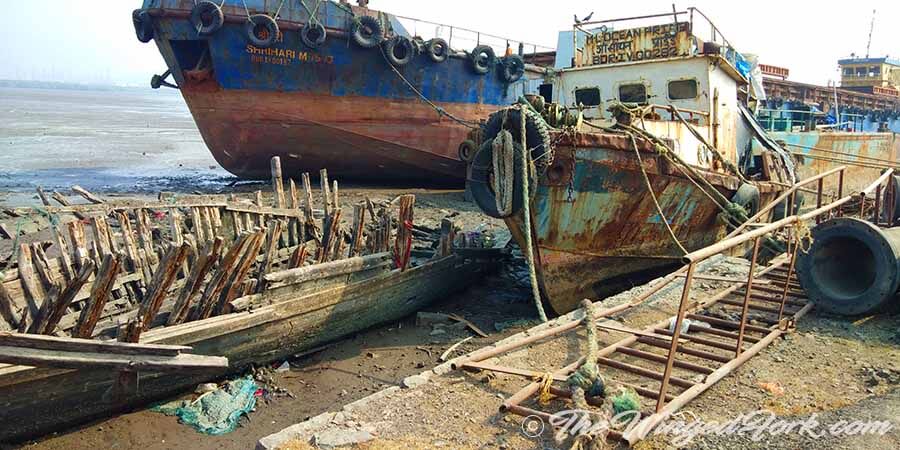
So we just caught a few shots of the many boats at the jetty. Some were on their last legs; some had even been stripped down to a bare hollow.
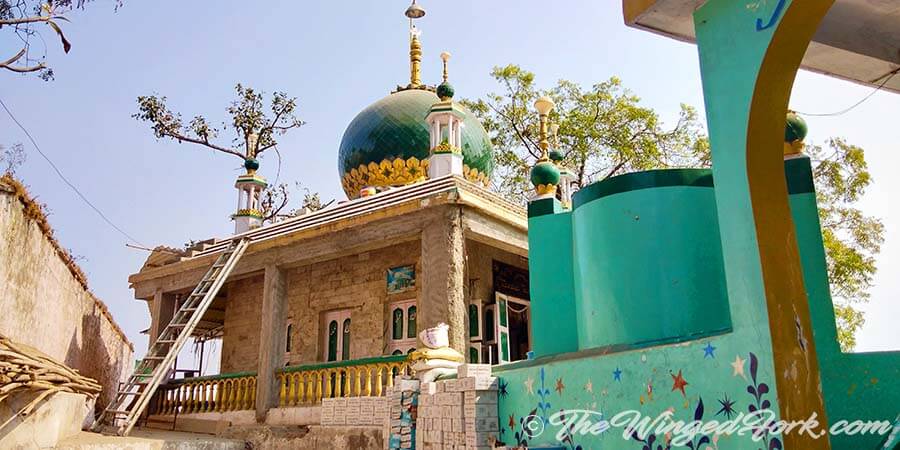
We then walk for about 10 minutes to the nearby Sewri Fort. Climb up the many steps past the buildings and the Jalal Shah Murad Shah Dargah, a shrine to honor their saints.
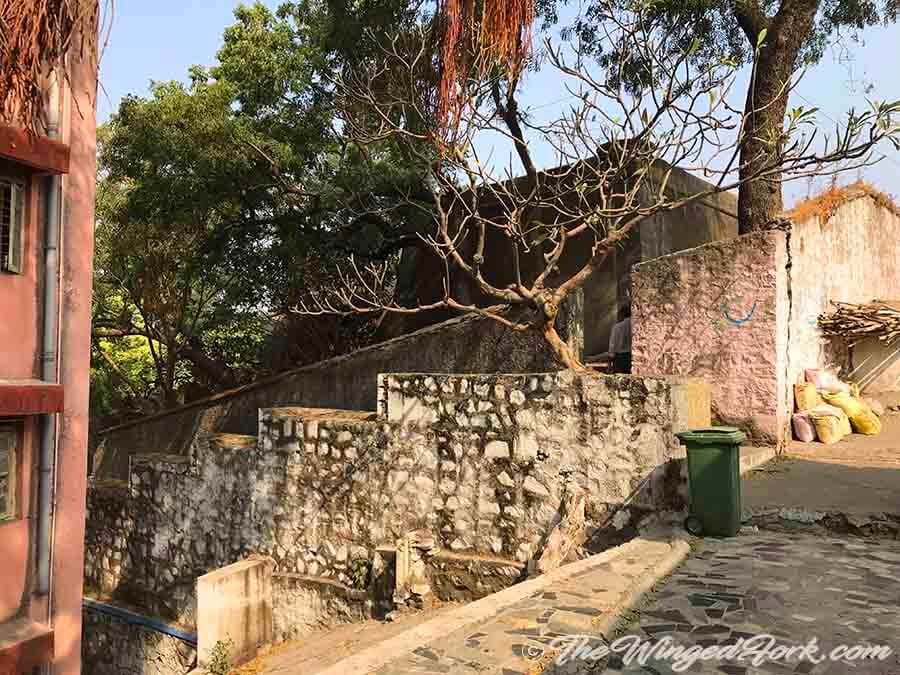
Enter the fort and see that it’s just a regular old fort.
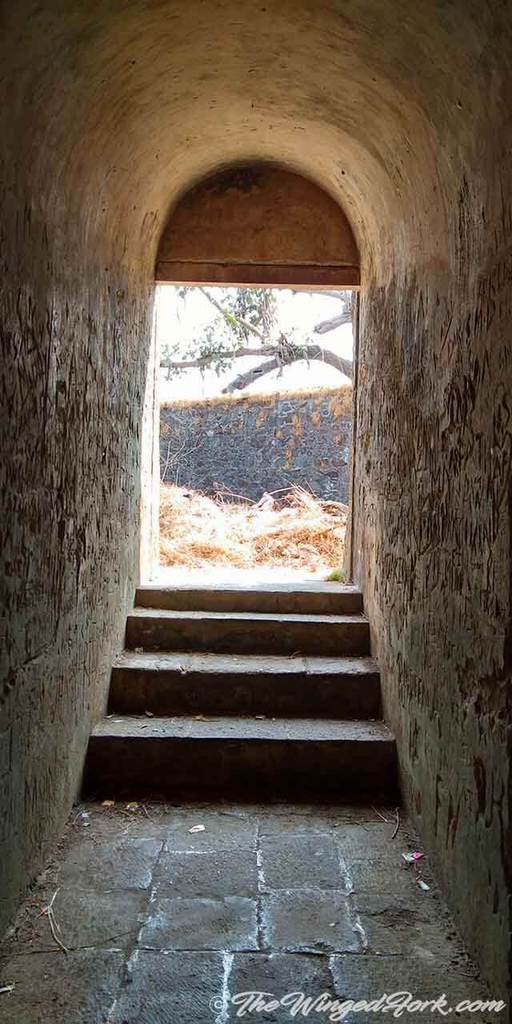
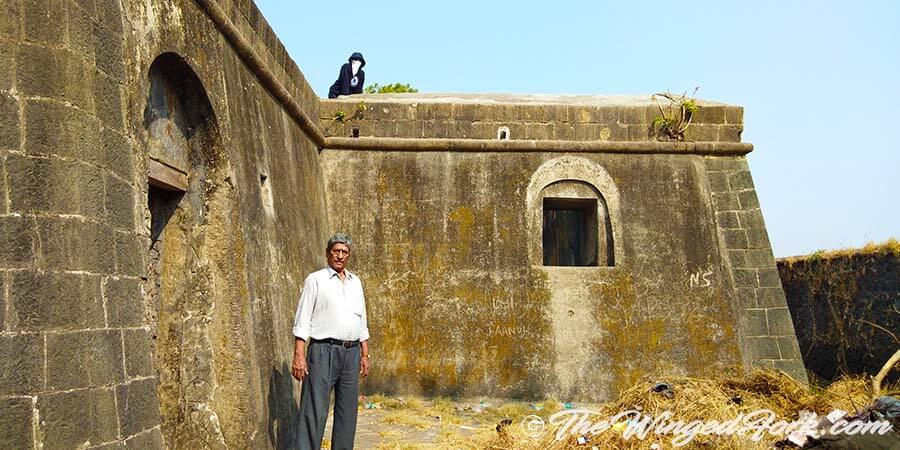
There are local kids playing there and hiding among the passageways.
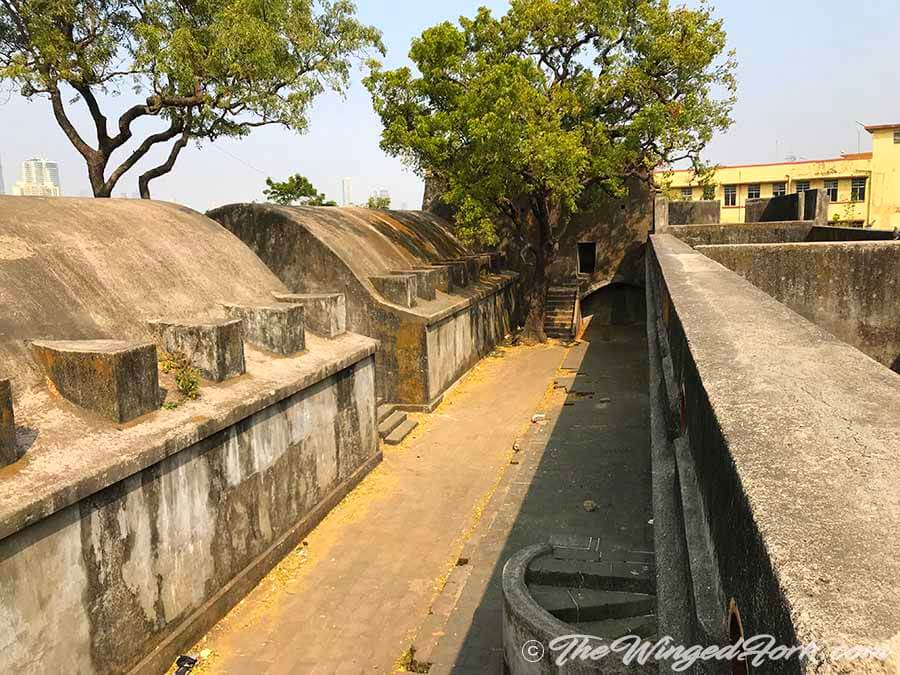
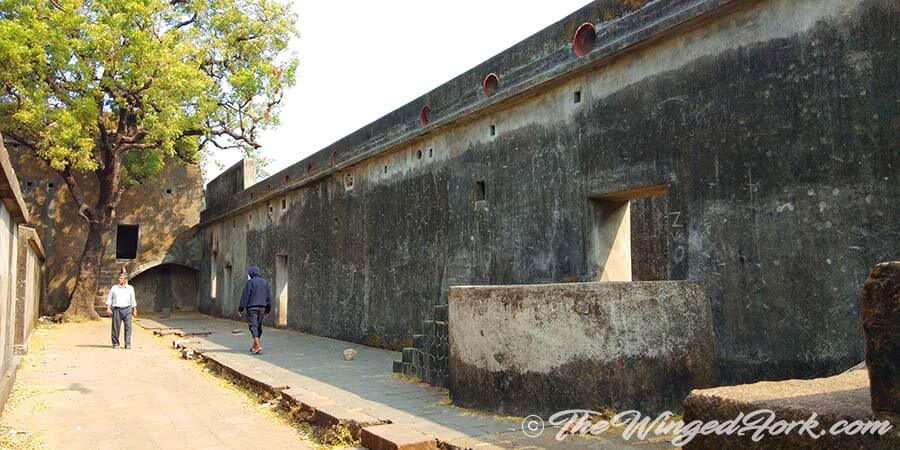
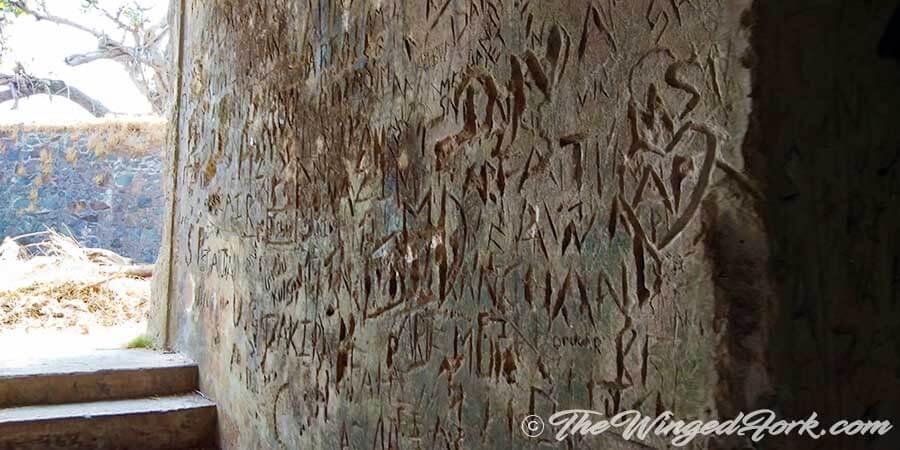
And as always, for every fort we see lovers writing their names in stone. This is just one more of those walls, like at the Cabo de Rama Fort in Goa.
But then we walk around and get to the other end of the fort. From there, standing on the edge with a drop down to the mangroves below us, we can see the flamingos.
Of course even with an iphone and a Vivo, they’re too far away to get decent pics. Sis should have been there.
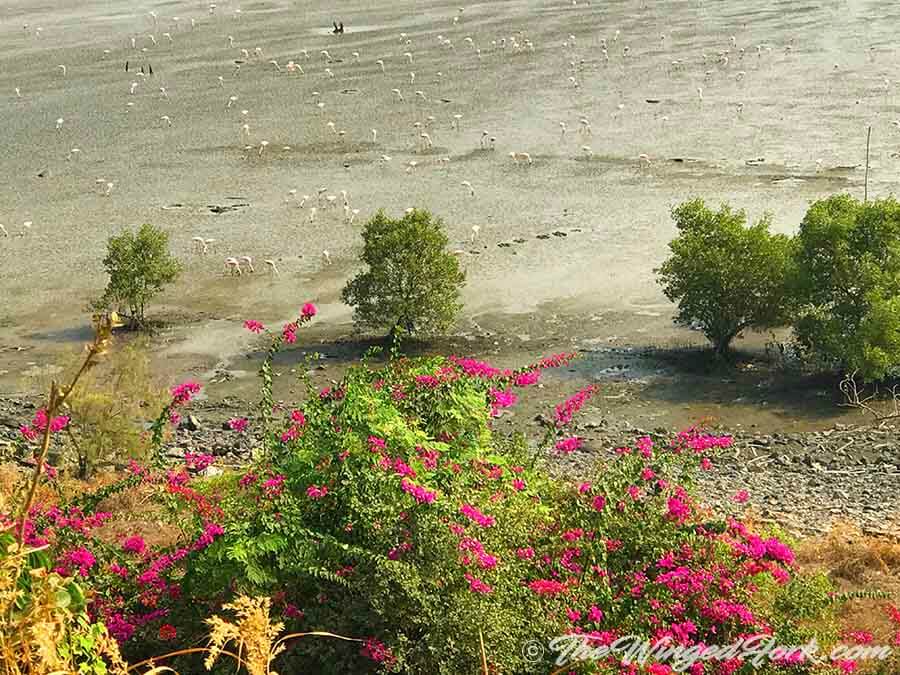
The flamingos and their little ones come down South from the Rann of Kutch from November to May. They had returned to Mumbai in 1994 after a break of 40 years, and can be seen in the 15-acre park that stretches all the way from the Sewri mudflats right up to Trombay.
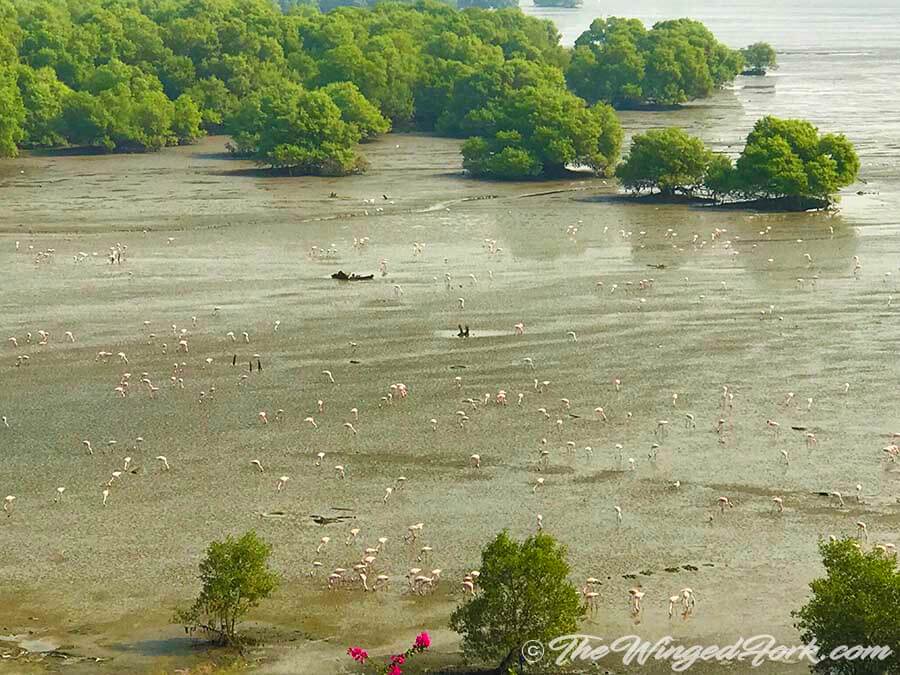
And then they flapped their wings in unison, pink and black in perfect waves. Tried to get that pic, but just got the half of it. Cry me a river now. Have you ever noticed how the natural eye sees so much sharper than the 24 MP and 32 MP cameras?
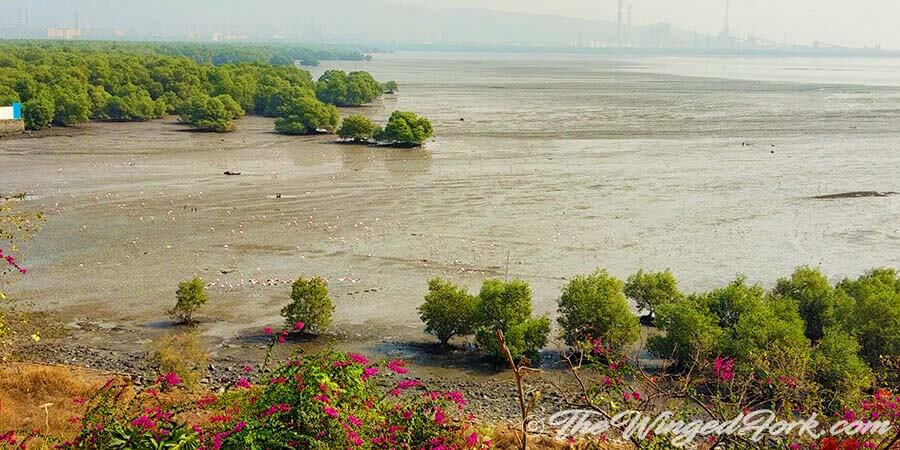
After we’re done taking pictures, just before we walk away, a voice from above our heads asks if we’re newspaper peeps. We look up to see a kid of about 13 or 14 wearing a grey taqiyah and dishdasha sitting there cross-legged. We just say no. We were too surprised by how he had managed to scramble to that part of the wall to say anything else.
Update 17 Jan 2019
Someone mentioned that the mangroves are closed to the public at the moment. So I got in touch with Nitya, a local bird-watching guide to ask her what the situation was. This is her reply.
When you had visited the place in November the number of flamingos were few. Their numbers have increased now. Although the sighting is not same as it used to be since the construction work has started.
Also their sighting is not best in mornings and evenings but is actually dependent on the tide timing. During low tide flamingos are extremely far to be seen from the jetty point.
During high tide, entire mudflats are covered with water, so ideal time to visit is around 3 hrs after the high tide when water starts receding and birds start coming to feed in the mudflats or around 4 hours prior to high tide when they start coming closer to the viewing point as the water starts coming closer to the shore.
Thane creek and Navi Mumbai are also good places to spot flamingos.
If you want to reach out to Nitya and go on one of her bird-watching tours, you can contact her at nitya@wildnest.in or +91-9967056674.
5. Salt Pans at Vashi
Dad and cousin brother DFon were wondering where on earth I wanted to go. They’d come along for the ride that morning since they’re better with directions than I am.
It’s good they did because the route Google Maps gave me turned out to be in the middle of nowhere and actually required an SUV.
The poor cab driver kept hitting the underside of the vehicle on the bumpy road till dad told him to tilt the car to the side and drive. So that led to us driving at an almost 30 degree angle and our heads bumping the top of the car every few minutes.
The driver was a good sport though and didn’t ditch us in the middle of nowhere. Soon we reached the salt pans and were thankful we hadn’t given up.
These are the salt pans in Vashi. I’ve seen them from the train before, but never close up. There are also salt pans in Vasai, but why would I go off road in Vasai that’s close to home, when I can go off road in Vashi, right? Daft, dumb, etc.

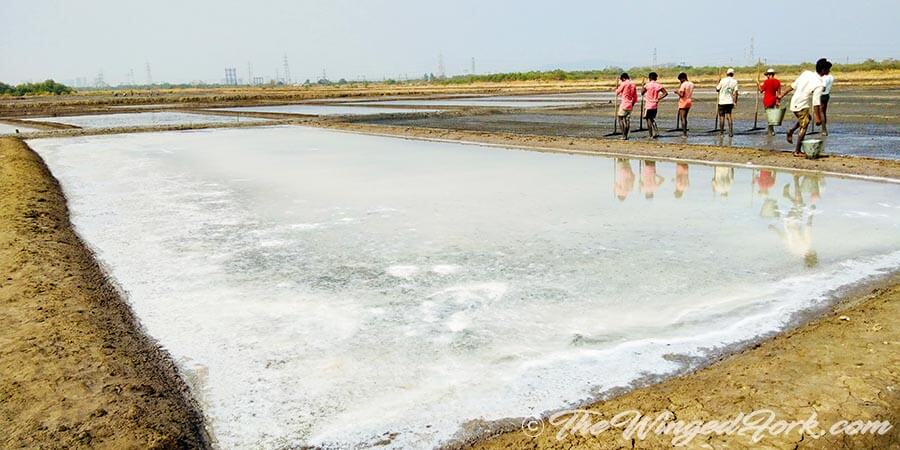
We find the workers and watch them for a long time. Dad finds one to explain the process of salt making to us. Here’s the short version. They have rows of large shallow pans that are filled with water from the ocean. Once the pans are filled, they are blocked off so that no more water flows into them.

The sun evaporates the water and salt brine is left. To aid in the drying process the brine is collected, moved to another pan and raked to aid in evaporation.
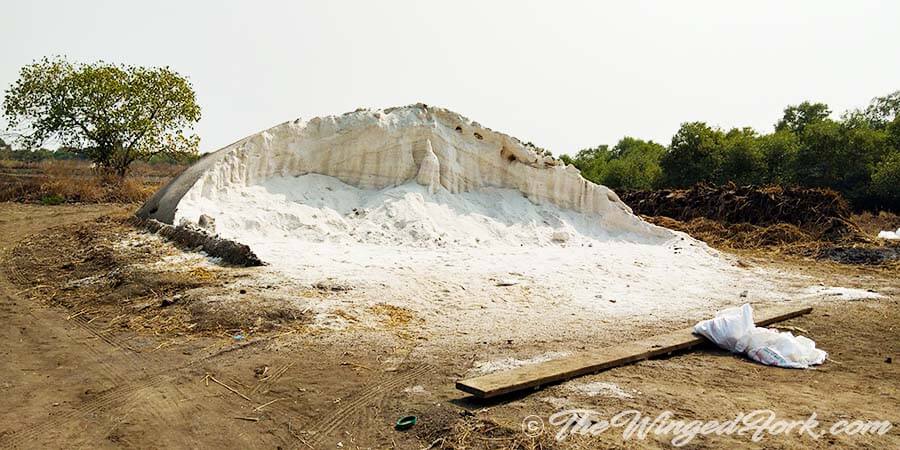
Since the pans we visited were larger, the process takes longer. The salt worker said that from start to finish it takes a total of 4 months.
Here’s a video I managed to take with a few butterflies flying around. I liked how the workers moved in sync. Interesting right?
Did you know that India is the third largest producer or salt in the world (after USA and China)? It produces about 230 million tones of salt, mostly in the states of Maharashtra, Gujarat, Odisha, Rajasthan, Tamil Nadu, Andhra Pradesh and Karnataka.
You can buy salt to take home. The guy first offered us a choice of 1 ton or 5 ton sacks. Ha! Maybe next time. This time we just took a few kgs of that pure fresh salt at a lower amount.
Oh, and while leaving the salt workers told us of a shorter route to the main road. So if you’re going for a visit, play around with Google maps for a while till you find the shortest off road path there. Or if you’re taking a SUV, don’t worry about whatever route you take. Enjoy.
Bombay is so much more than meets the eye. Experience her well! Enjoy her and remember her. If you have questions about Mumbai with regard to food, check the list of Mumbai’s old but gold places to eat.
And a PS. There’s always a PS. There are so many more places in Mumbai that I have to still discover. If you love a place in Mumbai that isn’t on this list yet, just email a pic and description to abby@thewingedfork.com and if we like it, we’ll add it in.
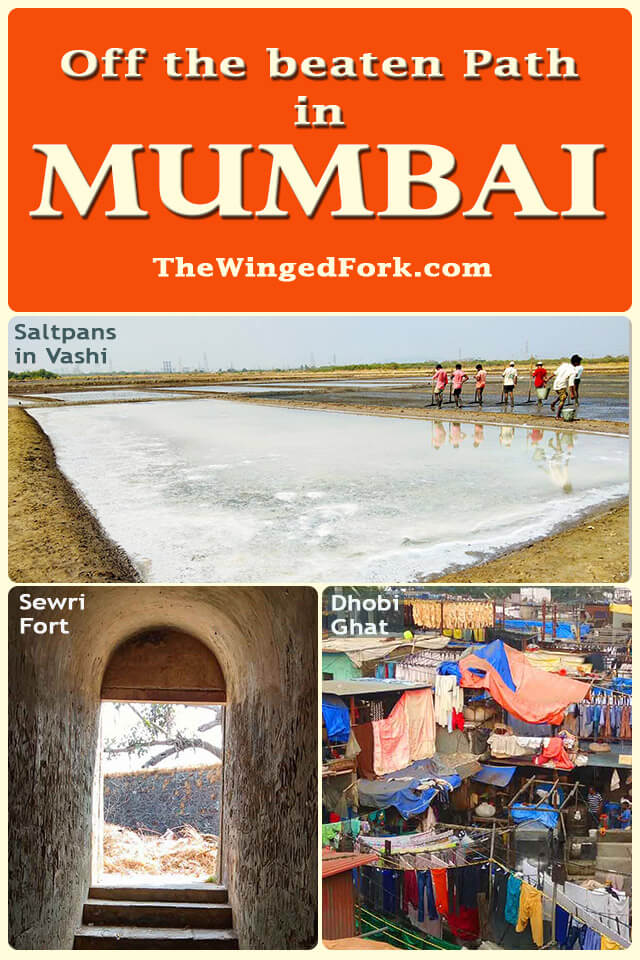
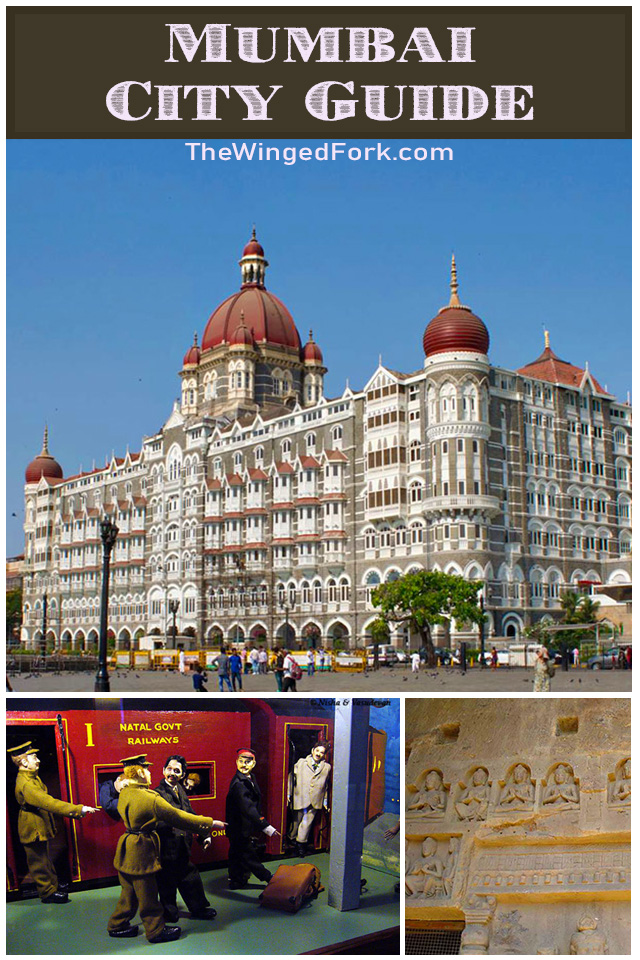
Other Posts About India You Might Like
- Jungle Book location in India
- Goan attractions offbeat
- What to eat in Lucknow
- Tiger safari
- How to build an igloo
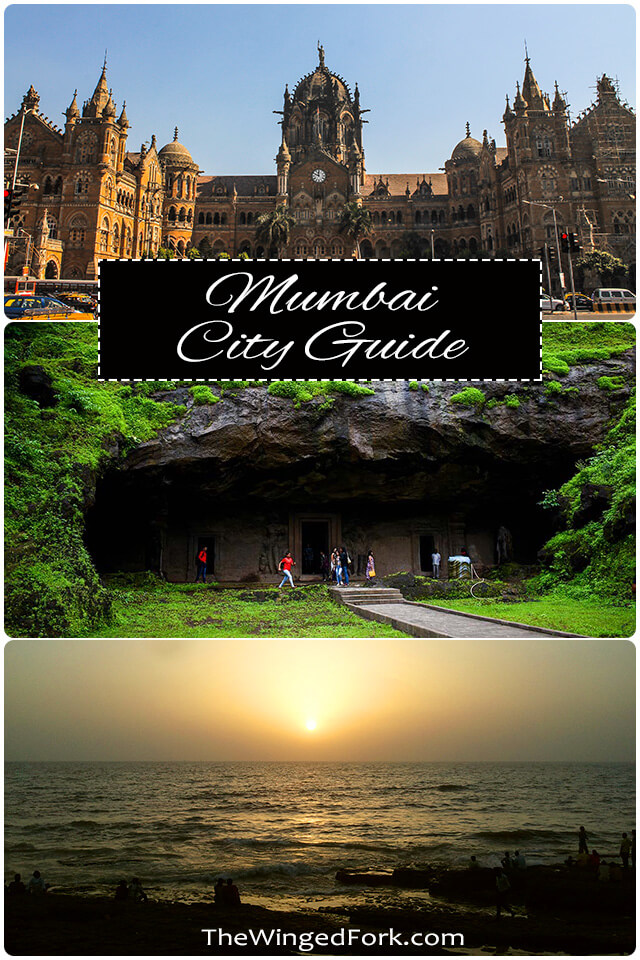
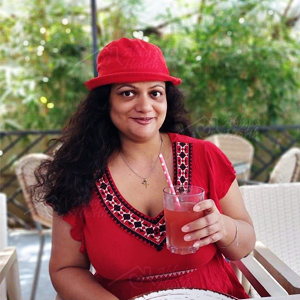
I’m an East Indian foodie and travel blogger from Bombay, India. I’ve travelled across parts of Europe and Asia, and love writing about my experiences with people and cultures. And naturally, I love food, wine, and travel, and have an endless bucket list of places to go to, and experiences I must blog about.
I also love baking and experimenting with food, with a little help from my family. If you must know, my favorite things are nice rainy days, the smell of cakes in the oven, playing in the snow, glasses of wine, and dark chocolate.
More info about me here!
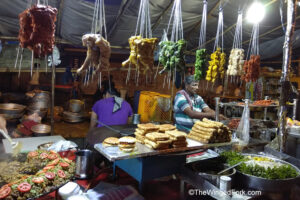
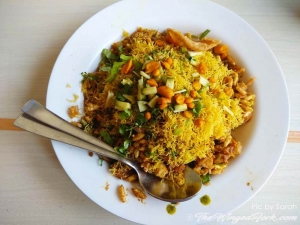
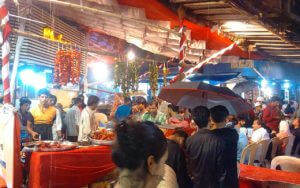
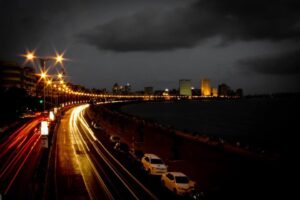
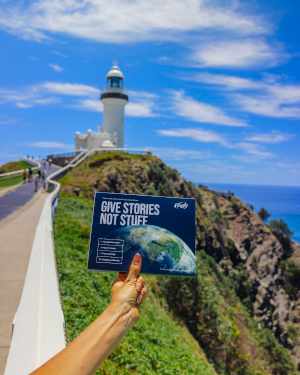
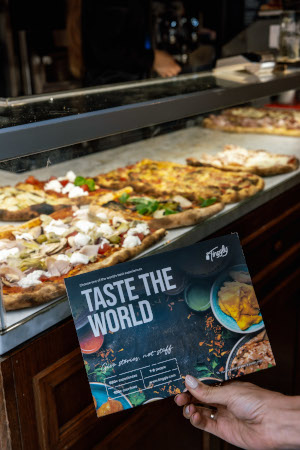
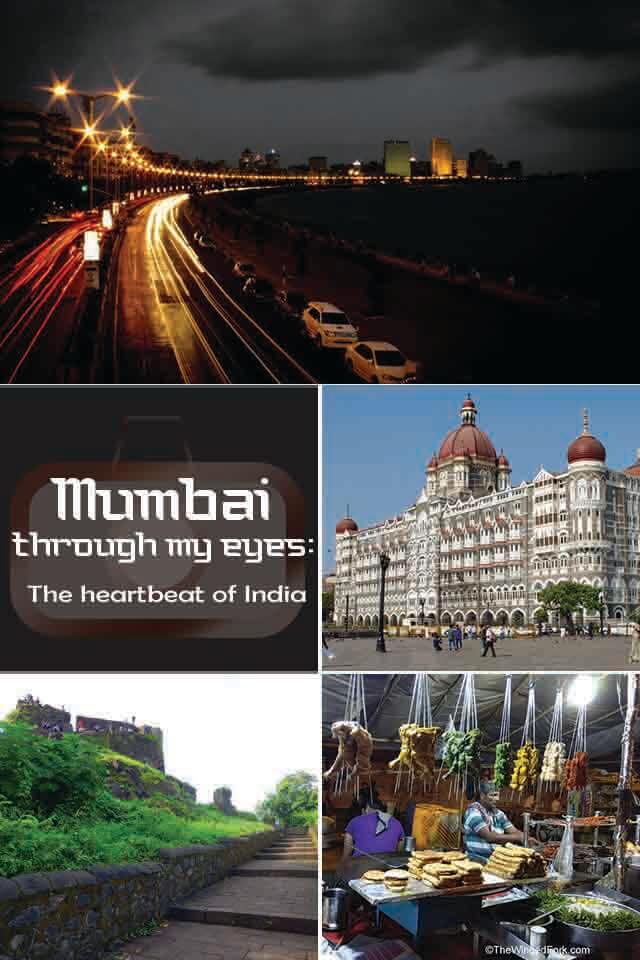
Awesome this what I was looking for! I think no blog is perfect like this. In this blog the information about Mumbai is given. Those who want to know about Mumbai in deep, I think this blog is for them. In this everything is given about places to eat. This is the best blog I have ever seen for Mumbai. Thanks for this I would like to see more like this!